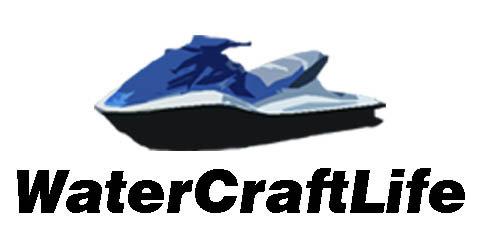

What Does Yacht Certified Mean and Why You Would Want It
If you are unfamiliar with yacht certification, you are encouraged to learn more about what it means and why it is so important for both current and prospective boat owners.
The term “Yacht Certified” refers to a quality control process governed by the NMMA, an organization that ensures that yachts and boats are constructed to industry standards. As many as 90% of boats currently on the water in the U.S. carry an NMMA certification placard.
The NMMA certification process serves to remove these headaches by requiring participating manufacturers to pass physical inspections.
What Does Yacht Certified Mean?
Yacht certification is handled by the National Marine Manufacturers Association (NMMA). The program is designed for manufacturers, so that they may show prospective boat buyers that the vessel has been built to meet or exceed the standards of the American Boats & Yacht Council (ABYC).
Every model of a manufacturer’s fleet must be inspected annually for Yacht Certification. If a company decides to participate in the NMMA program, they run every design plan by the organization and continue to produce vessels that meet these same standards.
What Are the Standards?
Standards are applied to the critical components of the yacht so that consumers know that they are purchasing a boat that has passed an extensive physical inspection. The following components are emphasized during the inspection process:
- Bilge pumps
- Bilge blowers
- Fuel hoses and tanks
- Steering parts
How Do Boats Qualify to Be Yacht Certified?
To meet the definition of a yacht, the boat must be 26 feet or longer. The NMMA does build capacity tags for boats shorter than 26 feet, so the certification process indeed covers a wide range of vessels.
Manufacturers apply for certification on their behalf and pay annual membership fees. They must also meet inspection filing deadlines once they have become NMMA members. As such, membership in the Yacht Certification program shows that a company is determined to meet or exceed industry standards.
How Do You Know A Boat Is NMMA Certified?
You will know a boat is Yacht Certified if you see a sticker showing “NMMA Certified using ABYC standards.” This will be located overtop either the capacity or yacht plate at the helm of the boat. You can ask your dealer if you don’t happen to notice the placard. If you go to a boat show, you may notice a directory that explicitly shows which boats among the lineup are NMMA certified.
Why You Would Want Yacht Certification
Prospective buyers can take advantage of the NMMA certification program as a way to ensure consistent quality across the board, regardless of manufacturer. For new owners, it is challenging to shop for boats. Prospective buyers don’t usually get to take a boat for a test drive, as they would with a vehicle.
Approximately 90% of all boats currently on the water in the United States are certified by the NMMA. From a manufacturer’s perspective, it is an excellent way to build trust with consumers.
Safety Standards of a Yacht Certified Boat
Since you won’t generally be able to go for a test drive, it’ll give you peace of mind to know that a vessel is a yacht certified by the NMMA. Research has shown that NMMA-certified boats are seven times less likely to receive safety recalls than non-certified boats.
While it’s true that the U.S Coast Guard inspects every new yacht for safety, the NMMA certification is an expansion of the standard federal inspection checklist. There aren’t any Coast Guard requirements for steering systems, storage batteries, or exhaust systems, among many other components.
Passenger Capacity on a Yacht Certified Boat
Recreational vessels longer than 26 feet in length are excluded from passenger capacity and stability standards. In smaller boats, you’ll notice marked placards somewhere along the interior, which clearly states passenger capacity and the maximum allowable weight.
Equipment Issues Can Be Hard to Diagnose
Just as is the case with cars and trucks, boat issues can be hard to diagnose. When you finally land your dream boat, the last thing you want on your hands is a mechanical issue that’ll land it in the shop for several days, if not weeks.
There are thousands of trained technicians who can determine whether a given component passes the ABYC test. If there are any issues, they can be resolved immediately while the vessel is still at the factory.
One of the many categories inspected to meet ABYC standards is electric wiring. This is significant because marine electrical systems are susceptible to a host of complicated problems, including bad connections, improper inverter installations, and poor choices for conductor materials.
Quality Assurance
The regulations of NMMA Yacht Certification state that participating manufacturers must have at least one staff member who is knowledgeable about ABYC standards. Participating staff must attend training sessions and successfully pass exams testing their level of competency.
As a prospective buyer, you’ll know that any craft that is NMMA Yacht Certified has been constructed under the guidance of a trained industry expert. This provides manufacturers with a convenient process for quality assurance.
Consistency
Every year manufacturers update their fleet to include new technology. There is no way of knowing the actual consequences of such modifications unless the boat is tested and approved by an independent technician.
The NMMA yacht certification program requires manufacturers to ensure that their boats are up to code every model year, even if no significant modifications have been made to the design schematic.
Consumer Satisfaction Index (CSI)
The Yacht Certification program provides makers with an established structure for tracking customer feedback. At the very least, companies must send their customers a census-type survey within the first 12 months of ownership. The NMMA then asks that the survey results are tabulated and forwarded up the chain to the manufacturer’s internal management.
Members also have the option to take part in the Marine Industry Customer Satisfaction Awards. This is a great way for prospective buyers to continuously view the top-rated brands and dealerships from this page.
How Long Do Yacht Certifications Last?
Certification inspections take place at the factory where the boats are originally manufactured. The dealerships do not generally take part in any certification process, so it’ll be more challenging to determine whether a used boat is up to code. You may find out that the vessel was originally Yacht Certified, which certainly helps with models that haven’t seen too much wear or tear.
Manufacturers provide owners with certification programs confirming the quality of used boats. Membership in such services involves having the yachts routinely maintained by certified technicians. The incentive for owners to enroll in such programs is that this coverage should help boost the resale value of their yacht.
Are There Any Other NMMA Certifications?
The NMMA has certification categories for many different types of watercraft, including personal watercraft. The organization also helps ensure that boat trailers are manufactured per code. Boat trailer inspections emphasize trailer and tire capacity ratings, brakes, and hand winches, among other critical components, to provide owners with peace of mind while they transport their prized possession.
Final Thoughts
Yacht Certification is a manufacturing quality vetting process hosted by the National Marine Manufacturers Association (NMMA). The standards are established under the guidance of the American Boats & Yacht Council (ABYC).
The advantage of the certification process is that consumers can be assured that the critical components of the boat have been inspected by a trained representative of an independent organization, a true neutral party.

- CREATE AN ACCOUNT
- Boat Cover Finder
- Bimini Top Finder
- Boat Propeller Finder
- Engine Parts Finder
- Anchor & Dock
- Watersports
- Clothing and Footwear
- Engine Parts
- Cabin and Galley
- Covers and Biminis
- Electronics
- Paint and Maintenance
- Pumps and Plumbing
- Anchor Chains & Ropes
- Boat Fenders
- Boat Mooring
- Boat Protection
- Dock Storage & Protection
- Ladders, Steps, & Platforms
- Top Sellers

- Fishing Rods
- Fishing Reels
- Fishing Rod & Reel Combos
- Fishing Tools & Tackle Boxes
- Fishing Line
- Fly Fishing
- Fishing Bait & Fishing Lures
- Fishing Rod Holders & Storage Racks
- Fish Finders, Sounders & Sonar
- Trolling Motors
- Fishing Nets
- Fishing Downriggers & Acessories
- Fishing Outriggers & Acessories
- Fishing Kayaks
- Fish Cleaning Tables

- Inflatable Rafts
- Paddle Boarding
- Paddles & Oars
- Wakeboard, Wakesurf & Ski
- Wakeboard Towers
- Tow Ropes & Handles
- Life Jackets & PFDs
- Snow Sports
- Roof Racks, Carriers, Dollies

Men's Clothing
- Accessories
Men's Footwear
- Atheltic Shoes
- Water Shoes
Women's Clothing
- Dresses & Skirts
Women's Footwear
- Fuel Systems
- Sacrificial Anodes & Zincs
- Generator Parts
- Inflatable Boats
- Propeller Parts & Accessories
- Boat Manuals
- PWC Parts & Accessories

- Fishing Boat Seats
- Offshore Boat Seats
- Ski Boat Seats
- Pontoon Boat Seats & Furniture
- Boat Seat Pedestals & Hardware
- Boat Seats by Manufacturer
- Boat Tables & Hardware
- Boat Seat Covers
- Boat Seat Vinyl
- Floating Boat Cushions

- Barbeque Grills
- Boat Drink Holders
- Cabin Accessories & Hardware
- Boat Ventilation
- Interior & Cabin Lighting
- Marine Teak Products
- Carbon Monoxide & Smoke Detectors
- Binoculars & Telescopes

Boat Bimini Tops
- Bimini Top Accessories
- Pontoon Bimini Tops
- Other Biminis
- RV & Trailer Covers
- Boat Shrink Wrap & Accessories
- Boat Shelters
Boat Covers
- Boat Cover Accessories
- Boat Lift Canopy Covers
- Other Covers
- Boat Wiring & Cable
- Marine Batteries & Accessories
- Marine DC Power Plugs & Sockets
- Marine Electrical Meters
- Boat Lights
- Marine Electrical Panels & Circuit Breakers
- Power Packs & Jump Starters
- Marine Solar Power Accessories
- Marine Electrical Terminals
- Marine Fuse Blocks & Terminal Blocks
- Marine Switches
- Shore Power & AC Distribution

- Marine Audio & Video
- GPS Chartplotters & Accessories
- Electronic Navigation Charts & Software
- Digital Instruments
- Display Mounts
- VHF Radios & Communication
- Marine Radar
- Auto Pilot Systems
- Action Cameras

- Fiberglass & Epoxy Boat Repair
- Boat Paint & Varnish
- Marine Adhesives, Sealant, & Caulking
- Marine Engine Maintenance
- Boat Cleaners & Waxes
- Boat Cleaning Supplies

- Fresh Water Boat Systems
- Bilge Pumps
- Marine Plumbing Parts
- Wash Down Pumps
- Livewell Aerator Pumps & Live Bait Wells
- Toilet & Waste Pumps
- Marine Pump Replacement Parts

- Tires, Rims, & Hub Kits
- Boat Trailer Winches
- Boat Motor Supports & Transom Savers
- Boat Trailer Guides & Rollers
- Boat Trailer Fenders
- Boat Trailer Lights
- Boat Trailer Hardware
- Boat Trailer Jacks
- Boat Trailer Brakes & Axles
- Boat Trailer Tie Downs
- Couplers, Mounts, Hitches, & Locks

- Boat Deck Harware
- Marine Nuts, Bolts, & Screws
- Boat Handles, Pulls, & Rings
- Prop Nut Kits & Hardware
- Boat Cabin Hardware
- Marine Fasteners
- Boat Windshield Parts
- Boat Tubing & Rails
- Boat Mirrors
- Marine Tools & Tool Kits
- Boat Lettering

- Women's Clothing Deals
- Men's Clothing Deals
- Fishing Deals
- Anchor & Dock Deals
- Electrical Deals
- Electronics Deals
- Paint & Maintenance Deals
- Pumps & Plumbing Deals
- Boat Seats Deals
- Trailering Deals
- Camping & RV Deals
- Dealer Login

- Forums Login

- Search forums
- The iboats forum moderators would like to mention to all the iboaters here that we’re sorry but the website server seems to be running on half a cylinder and in order to post pictures, etc. you may have to use an outside hosting source, which we understand is not ideal, but its all we got at present. We are hoping that the administration can rectify this issue soon, but unfortunately at this time we can make no promises as to when... we have been working on letting the higher powers that be 'know of the situation... hang in there iboaters, we've been through a lot over the years and this is just another rough weather system rolling through to endure is all. Thank you.
- General Boating/Outdoors Activities
- Boat Topics and Questions (not engine topics)
passenger capacity: Yacht Certified - What does this mean?
- Thread starter lkbum
- Start date Jul 27, 2009
Chief Petty Officer
- Jul 27, 2009
My boat is 28' (30' OAL) and the capacity plate states - Pasenger Capacity:Yacht Certified. Not that big a deal to me, but I was asked this weekend and I don't have a clue .
tashasdaddy
Honorary moderator emeritus.
Re: passenger capacity: Yacht Certified - What does this mean? http://www.nmma.org/certification/programs/yachts/
CaptNCamille
Petty officer 2nd class.
Re: passenger capacity: Yacht Certified - What does this mean? Boats 20' LOA and longer do not need to have the passenger capacity on the certification plate. There are some overly simplistic formulas for determining passenger capacity [number of people = the vessel length in feet times the vessel width in feet divided by 15] and actual ones which the USCG and marine engineers use http://www.uscgboating.org/safety/boatbuilder/safeloading_landing.htm . And then there are the common sense rules, don't overload your boat, which is what I use.
Re: passenger capacity: Yacht Certified - What does this mean? Thanks, I did look at the NMMA site before the post. The plate on the boat is vague. A passenger ask me how to determine capacity from the plate that indicated "Yacht Certified". I have not seen the coast guard link before, thanks for that. And the only overloading on my boat is the First Mate when she brings Red Wine along.
Bubba1235 said: Ummm, I think the cut off point is 26'. Click to expand...
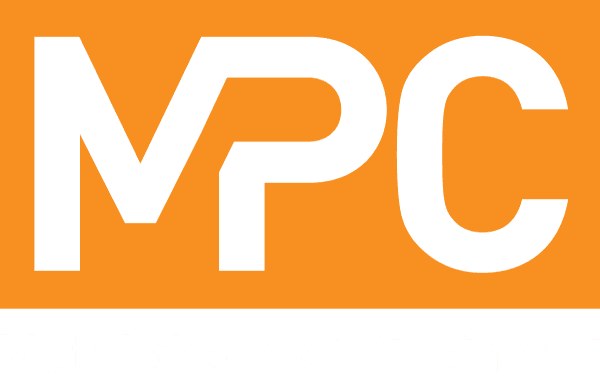
- Nameplate Designer
- Panels & Faceplates
- Graphic Overlays
- Labels & Tags
- Architecture
- Heavy Equipment
- Industrial Engines & Pumps
- Manufacturing
- Marine & Shipbuilding
- Professional Audio Equipment
- Transportation & Logistics
- AlumaMark BlackPLUS
- Anodized Aluminum
- Stainless Steel
- Polycarbonate
- Flexible Magnetic
- Certifications
- ISO Certified
Yacht Certified: What is it, How Does it Work?
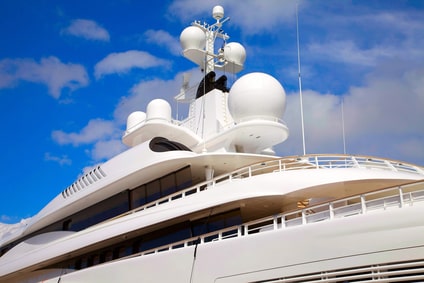
Table of Contents
- What is Yacht Certification?
- How Vessel Certification Works
- Placard Required Information
- Why NMMA Certification Tags Matter
- Further Considerations for Yacht Certification
Key Takeaway
- Yacht Certification, provided by the National Marine Manufacturers Association (NMMA), confirms that a boat model meets all ABYC standards of safety, design, and construction, serving as a crucial indicator of quality and safety for vessels 26 feet or larger.
When it comes to purchasing and operating a yacht, there are a lot of factors to keep in mind. Beyond maintenance, safety, and maritime laws, there are also considerations regarding the construction of the vessel that can often lead to more questions than answers.
One common question seen time and time again is related to the “Yacht Certification” tag seen on many larger boats. What exactly does it mean and when is it necessary? This post will help clear things up and explain why yacht certification is an important consideration for boat owners.
Yacht Certification is provided by the National Marine Manufacturers Association (NMMA) to confirm that a particular boat model has been manufactured to meet all ABYC standards of safety, design, and construction. The manufacturer must undergo an annual inspection to maintain certification.
To round out the process, each vessel is tagged with a permanent “Yacht Certification” plate.
The most influential group in the world of boat manufacturing is the NMMA, an organization that ensures a wide variety of vessels are constructed to the highest standards possible. The NMMA provides certifications to manufacturers of recreational boats who meet standards set by the American Boats & Yacht Council (ABYC) . Boat builders can become members of NMMA, have their vessels certified, and even undergo routine audits to ensure compliance against the frequently evolving standards.
There are two main types of NMMA placards you will see on recreational vessels. For boats less than 26 feet in length (and all pontoon boats), a ‘Capacity Tag’ is used, listing NMMA and U.S. Coast Guard safety standard compliance statements and information about the max capacity of the vessel. Vessels 26 feet or larger will have a ‘Yacht Certification’ plate with compliance statements, but no capacity information.
The main reason for this difference is that federal law dictates that all vessels 20 feet or smaller must contain capacity information . NMMA takes a more conservative approach and requires any NMMA-certified vessel under 26 feet to have this. Currently, there are no federal laws regarding capacity management for larger vessels 26 feet and longer.
Buying a boat with NMMA tags is important because, when present, both consumers and legal bodies know that the boat was manufactured to meet an extensive set of requirements that go beyond the basic federal mandates. There are currently 58 ABYC standards grouped into 31 categories that NMMA uses to certify all vessels, including steering, power, and electrical systems, among many others. Additionally, the manufacturers are required to undergo routine inspections from third-party providers to ensure ongoing compliance. Data from the U.S. Coast Guard indicates that NMMA-certified boats are safer than non-certified.
As a potential or existing owner/operator of a 26 foot or larger vessel, it is important to remember that ‘Yacht Certification’ does not include any required vessel capacity limits, and it is up to the boat owner to operate mindfully. The main reason for this lack of guidance is that the larger size of these vessels leads to maximum capacity calculations that are determined by “stability” rather than “displacement” as in smaller boats. Larger boats can typically fit more passengers than seating capacity, so the overall stability of the vessel is what matters most. You can usually find a stability analysis to use as a basis of a maximum capacity estimate in the design documentation from the boat manufacturer.
Moreover, the NMMA ‘Yacht Certification’ tag is installed during, and is representative of, the manufacturing of the vessel. This means that further modifications that may have been made since or from previous use should be assessed before purchasing a used boat. The certification is a matter of construction quality and not an ongoing representation of the vessel’s compliance and adequate safety measures.
There are often many tags displayed inside a vessel, but the ‘Yacht Certification’ plate provided by NMMA is an important one to look for. Understanding the context of why and how these plates were initially attached can help buyers and operators make more informed decisions for smarter, safer operation.
Questions about the article? Let us help!
Our sales engineers are experts in automatic asset tracking, tagging and identification,a nd can answer all your questions. Get in touch now.
You May Also Enjoy...
The articles here will be one category that is also tagged in this article so that users get articles similar to their interests. Blog Home ›

Everything You Need To Know About Aluminum and Metal Sign Blanks
Aluminum and metal sign blanks are ideal for creating signs that are both durable and visually appealing. These versatile materials have many advantages over other sign substrates, which makes them …
Which Tracking Devices To Buy for Your Equipment? Everything You Need To Know
Whether your team works in the field or in an office, you rely on equipment to keep your business running. However, you invested a lot of resources into this equipment …
5 Benefits of RFID Location Tracking for Defense Logistics
From supply chain management to infrastructure management to transportation, logistics requires managing several moving parts. However, defense logistics is even trickier to navigate because of strict regulations and sensitive materials. …
Create The Ideal Solution For Your Product Identification Needs

- Captains Queen Yacht
- Lady of Sea
- Black Princess
- 135 Feet Yacht
- Desert Rose
- Java Yacht Rental Dubai
- Lotus Mega Yacht Dubai
- Birthday Parties
- Corporate Charter
- Wedding Charter
- Family Gatherings
- Limo Rental
- Share A Yacht
- Dhow Cruise
- New Years Eve Yacht
- Lotus Mega Yacht Brunch
- Megayacht Dinner Cruise

Unraveling the Mystery of Yacht Certification: What Does it Really Mean?

what does yacht certified mean? Yacht certification is a process that evaluates a yacht’s safety, performance, and overall quality to ensure it meets necessary requirements for safe operation in various waters. Understanding the details of yacht certification is important for all yacht owners to ensure the safety of their vessel and those on board. Therefore, if you are considering a yacht charter Dubai , make sure to select a rental company that also possesses the necessary yacht certification to ensure a safe and enjoyable experience on the water
What does Yacht Certification mean?

Yacht certification involves a comprehensive evaluation of a yacht’s design, construction, safety features, and other factors that determine its seaworthiness. The certification process is conducted by recognized certification bodies that assign a certification level or category to indicate the yacht’s suitability for specific types of water and weather conditions.
Who gave yacht certificate?
The NMMA (National Marine Manufacturers Association) certification process is designed to ensure that yachts and boats are constructed to industry standards. The NMMA works with manufacturers to establish a set of standards that ensure that yachts and boats are safe, reliable, and meet environmental requirements. Yachts that meet these standards are considered to be “NMMA certified.”
Yachts that pass the NMMA certification process are issued a certification placard that indicates that the yacht has met all applicable standards. This placard is typically displayed on the yacht’s dashboard or other visible location. In addition to providing reassurance to yacht owners, the NMMA certification can also be helpful in the event of an insurance claim or other legal issue.
Which physical inspection is important for NMMA certificate?
The NMMA certification process involves a series of physical inspections that are conducted by independent inspectors. The inspections cover a range of topics, including construction materials, fuel systems, electrical systems, and safety equipment. The inspections are designed to ensure that the yacht meets all applicable standards and regulations, and that it is safe and reliable for use on the water.
How do boats qualify for certificate?
In order to be eligible for yacht certification, a boat must have a length of 26 feet or longer, according to industry standards. However, the NMMA also provides capacity tags for boats shorter than 26 feet, meaning that the certification process covers a wide range of vessels.
To become certified, boat manufacturers must apply for certification on their own behalf and pay annual membership fees to the NMMA. Once they become members, they are required to meet inspection filing deadlines as part of the certification process. By becoming a member of the Yacht Certification program, manufacturers demonstrate their commitment to meeting or exceeding industry standards for safety, reliability, and environmental impact.
How to get information about a boat certification?
A boat that has been NMMA certified will have a sticker that reads “NMMA Certified using ABYC standards” located either over the capacity or yacht plate at the helm of the boat. If you are unsure whether a boat is certified or not, you can always ask your dealer. Alternatively, if you attend a boat show, you may find a directory that explicitly lists which boats in the lineup are NMMA certified.
Is there any other NMMA certificate?
Yes, the NMMA has certification categories for various types of watercrafts, including personal watercraft, pontoons, and fishing boats, among others. The NMMA’s Certified Trailer program ensures that boat trailers are also manufactured per code. These inspections emphasize trailer and tire capacity ratings, brakes, and hand winches, among other critical components, to provide owners with peace of mind while they transport their prized possessions.
Why is Yacht Certification Important?

In addition to ensuring the safety and seaworthiness of a yacht, certification is important for several other reasons:
Requirement for yacht owner to operate vessel
First, certification is often a requirement for yacht owners who want to operate their vessel in certain waters. Many countries have regulations that require yachts to be certified before they can be operated within their waters, and failure to comply with these regulations can result in penalties and fines.
Insurance purpose
Second, certification is important for insurance purposes. Many insurance companies require yachts to have a certain level of certification before they will provide coverage. This is because certification indicates that a yacht has met certain safety and performance standards, reducing the risk of accidents or damage. Without certification, yacht owners may have difficulty obtaining insurance coverage or may face higher premiums.
Helps in resale value
Third, certification can be important for resale value. A yacht that has been certified to meet certain standards may be more attractive to potential buyers, as it indicates that the yacht has been well-maintained and is safe and seaworthy. This can be especially important for owners who plan to sell their yacht in the future.
Important for environmental sustainability
Finally, yacht certification is important for environmental sustainability. Some certification schemes evaluate a yacht’s emissions, noise levels, and other factors that can affect the marine environment. By meeting these standards, yacht owners can reduce the environmental impact of their vessel and contribute to a more sustainable yachting industry.
Yacht Certification Standards
Yacht certification standards are a set of guidelines that provide a framework for evaluating the safety and performance of yachts. Various yacht certification schemes exist globally, including the European Union’s Recreational Craft Directive (RCD), the American Boat and Yacht Council (ABYC) standards, and the International Organization for Standardization (ISO) standards.
Benefit of yacht certification levels
Yacht certification levels and categories are used to classify yachts based on their intended use and the conditions for which they are suitable. These categories and levels can vary depending on the certification scheme and the country in which the yacht is registered.
Each certification scheme may use different standards or criteria to assess yachts. Some schemes may focus on safety and performance, while others may emphasize environmental impact or other factors. Yacht owners should carefully research the certification schemes that apply to their yacht and ensure that they meet all applicable standards and criteria. This can help to ensure that the yacht is operated safely, legally, and in compliance with all relevant standards and regulations.
In general, yachts that are certified to higher levels or categories are designed to withstand more extreme conditions and are generally considered to be safer and more seaworthy. Yacht owners should ensure that their vessel meets the necessary certification standards for its intended use and operating conditions.
List of some Common certification levels

Before discussing the levels, let’s have a look at some important things to consider for each yacht. In the NMMA certification process, a yacht is inspected to ensure that it meets industry standards for safety, reliability, and environmental impact. This includes a detailed inspection of critical components of the yacht, such as bilge pumps, bilge blowers, fuel hoses and tanks, horns, lights, and steering parts.
Bilge pumps are an essential safety feature of any yacht, as they help to remove water from the bilge area. During the NMMA inspection process, bilge pumps are checked to ensure that they are functioning properly and that they are of the appropriate size and capacity for the yacht.
Bilge blowers are another important safety feature that helps to prevent the buildup of dangerous gases in the bilge area. During the NMMA inspection process, bilge blowers are checked to ensure that they are functioning properly and that they meet industry standards for safety.
Fuel hoses and tanks are critical components of the yacht’s fuel system, and they must be constructed to meet industry standards for safety and reliability. During the NMMA inspection process, fuel hoses and tanks are checked for leaks, cracks, and other defects that could pose a safety hazard.
Horns and lights are important safety features that help to ensure that the yacht is visible and audible to other boats and vessels. During the NMMA inspection process, horns and lights are checked to ensure that they are functioning properly and that they meet industry standards for safety and visibility.
Finally, steering parts are a critical component of the yacht’s control system, and they must be constructed to meet industry standards for reliability and safety. During the NMMA inspection process, steering parts are checked for wear, corrosion, and other defects that could pose a safety hazard.
By focusing on these critical components of the yacht, the NMMA certification process helps to ensure that consumers can purchase a boat that has passed an extensive physical inspection and that meets industry standards for safety and reliability. Yacht owners should look for the NMMA certification placard when purchasing a yacht to ensure that they are getting a safe and reliable vessel.
Here are some common examples of certification levels:
RCD Categories
The RCD is a set of safety and environmental standards that apply to recreational boats and yachts in the European Union. The RCD sets out minimum safety requirements for the design and construction of boats and yachts, including requirements for stability, buoyancy, ventilation, and safety equipment. The RCD also includes environmental standards related to noise, exhaust emissions, and fuel consumption.
The Recreational Craft Directive (RCD) categorizes yachts into four categories: A, B, C, and D. These categories are based on the yacht’s design and intended use. Category A yachts are designed for use in winds over Force 8 (Beaufort Scale) and waves over 4 meters. Category B yachts are designed for use in winds up to Force 8 and waves up to 4 meters. Category C yachts are designed for use in winds up to Force 6 and waves up to 2 meters. Category D yachts are designed for use in calm waters, such as inland lakes and rivers.
ABYC Standards
The ABYC is a non-profit organization that develops safety standards for boats and yachts in the United States. The ABYC standards cover a wide range of topics, including electrical systems, fuel systems, ventilation, and safety equipment. The ABYC standards are widely used in the US and are recognized by many insurance companies and regulatory agencies.
The American Boat and Yacht Council (ABYC) has established numerous standards for the design and construction of yachts. These standards cover a wide range of factors, such as electrical systems, fuel systems, and propulsion systems. Yacht builders and owners can consult the ABYC standards to ensure that their vessel meets the necessary safety and performance criteria.
ISO Certification
The ISO is a global organization that develops standards for a wide range of products and services, including boats and yachts. The ISO standards cover a range of topics, including design and construction, safety equipment, and environmental considerations. The ISO standards are recognized internationally and are used by many yachts’ certification schemes.
The International Organization for Standardization (ISO) has established a set of standards for quality management and environmental sustainability. ISO certification can be obtained for specific areas of yacht design and construction, such as hull design, electrical systems, or environmental management.
Country-Specific Standards
Many countries have their own certification standards for yachts. For example, the United States Coast Guard has established standards for certain types of vessels, such as passenger vessels, commercial vessels, and fishing yacht rentals .
Environmental Considerations in Yacht Certification

Environmental considerations are an important factor in yacht certification. As concern grows over the impact of yachting on the marine environment, many yacht certification schemes now include criteria related to environmental sustainability. Here are some of the environmental considerations that may be included in yacht certification:
Some yacht certification schemes require that yachts meet specific emissions standards. This may include limits on the amount of greenhouse gases, particulate matter, or other pollutants that are emitted by the yacht’s engines or other systems.
Yacht noise can be disruptive to marine life, particularly in areas where there are sensitive species or habitats. Some yacht certification schemes require that yachts meet specific noise level standards in order to reduce their impact on the marine environment.
Waste management
Yachts generate a significant amount of waste, including sewage, graywater, and other types of waste. Some yacht certification schemes require that yachts have appropriate waste management systems in place to minimize their impact on the marine environment.
Environmental management
Some yacht certification schemes require that yachts have a documented environmental management plan in place. This may include measures to minimize the yacht’s impact on the marine environment, such as reducing fuel consumption, using eco-friendly cleaning products, or avoiding sensitive areas.
By incorporating environmental considerations into yacht certification, yacht owners can help to reduce the impact of yachting on the marine environment. Yacht certification bodies may require documentation or testing to demonstrate compliance with environmental criteria, and yacht owners may need to take specific actions to meet these criteria. Ultimately, by meeting environmental certification criteria, yacht owners can help to ensure a more sustainable future for the yachting industry.
Insurance and Legal Considerations
Insurance and legal considerations are important factors in yacht certification. Here are some of the considerations that may be included:
Insurance requirements
Many yacht certification schemes require that yachts have appropriate insurance coverage in place. This may include coverage for liability, hull damage, and other types of risks. Insurance requirements can help to ensure that yacht owners are financially protected in the event of an accident or other incident.
Compliance with local laws and regulations
Yachts must comply with local laws and regulations in the countries where they operate. Some certification schemes require that yachts meet specific legal requirements, such as safety or environmental regulations, in order to be certified.
Yacht owners can be held liable for accidents or incidents that occur on their yacht. Certification schemes may require that yachts meet specific safety or other criteria in order to minimize the risk of accidents or incidents.
Documentation and record-keeping
Yacht owners may need to keep detailed documentation and records related to their yacht’s certification status, insurance coverage, and compliance with local laws and regulations. This documentation can help to demonstrate compliance and protect the yacht owner in the event of legal or insurance disputes.
Crew training and certification
Yacht crew members may need to meet specific training and certification requirements in order to operate the yacht safely and effectively. Certification schemes may require that yacht owners ensure their crew members have appropriate certifications and training.
By addressing insurance and legal considerations as part of the yacht certification process, yacht owners can help to ensure that their yacht is operated safely and in compliance with local laws and regulations. This can help to protect the yacht owner from financial and legal risks, and can help to ensure a safe and enjoyable experience for everyone on board.
Maintenance Considerations in Yacht
Different Types of Yacht Certification Different types of yachts may require different certification requirements. Commercial yachts may require different certification standards than private yachts. Sailing yachts, motor yachts, and other types of vessels may also have different certification requirements.
Here are some of the different types of yacht certification

Commercial certification
Commercial yachts are typically used for charter or other commercial purposes, and may require specific certification standards in order to operate legally. Certification requirements for commercial yachts may include safety equipment, crew training, and other criteria related to the yacht’s intended use.
Private certification
Private yachts are typically used for personal use and may have different certification requirements than commercial yachts. Private yacht certification may include safety equipment, environmental criteria, and other factors related to the yacht’s safe operation and environmental impact.
Class certification
Class certification is a type of certification that is offered by classification societies. These societies are independent organizations that assess the design, construction, and operation of ships and yachts. Class certification may be required by some insurers or regulatory bodies.
Flag state certification
Flag state certification is a type of certification that is issued by the country where the yacht is registered. The flag state is responsible for ensuring that the yacht meets the country’s legal requirements, including safety, environmental, and other criteria.
Manufacturer certification
Some yacht manufacturers offer certification programs that certify the yacht’s design, construction, and performance. These programs may be used to demonstrate compliance with regulatory or insurance requirements, or to provide additional assurances to potential buyers.
Each type of yacht certification may have different criteria and requirements. Yacht owners should carefully research the certification requirements that apply to their yacht and ensure that they meet all applicable criteria. This can help to ensure that the yacht is operated safely, legally, and in compliance with all relevant standards and regulations.
How many passengers can get to certified yacht?

When it comes to yacht certified boats, passenger capacity and stability standards only apply to recreational vessels that are shorter than 26 feet in length. For larger boats, these standards are not required.
In smaller boats, you can typically find marked placards somewhere along the interior that clearly state the passenger capacity and maximum allowable weight. This is important information to keep in mind to ensure that you do not exceed the weight limit and risk compromising the safety and stability of the boat.
Customer satisfaction index
In addition to physical inspections and certification, the Yacht Certification program also offers a way for manufacturers to track customer feedback through the Consumer Satisfaction Index (CSI). Companies are required to send a survey to their customers within the first 12 months of ownership, and the results are then tabulated and forwarded to the manufacturer’s internal management.
Participating manufacturers can also choose to take part in the Marine Industry Customer Satisfaction Awards, which is a great way for prospective buyers to view the top-rated brands and dealerships. This information is easily accessible through the program’s website and can help consumers make informed decisions when purchasing a yacht.
How long does the certificate last?
It is important to note that yacht certifications do not last indefinitely. Certification standards are revised every few years, so it is important to keep up with the latest requirements to maintain certification. Generally, certification lasts for a few years before requiring a re-inspection and recertification.
The exact duration of certification varies depending on the specific certification program and the type of yacht being certified. For example, the European Union’s Recreational Craft Directive (RCD) certification lasts for ten years, while the American Boat and Yacht Council (ABYC) certification requires annual renewal. It is essential to consult with the specific certification program to understand the duration of certification and any requirements for renewal.
Yacht certification is a critical process that ensures the safety, performance, and environmental sustainability of yachts. Understanding the certification process and maintaining a yacht’s certification is important for all yacht owners to ensure their vessel is safe and compliant with relevant standards.
Related Blogs:
- How to find the best yacht charter company?
- Tips For a Safe Yacht Charter in Dubai
- Tips you should know before have yacht ride Dubai
Latest Article
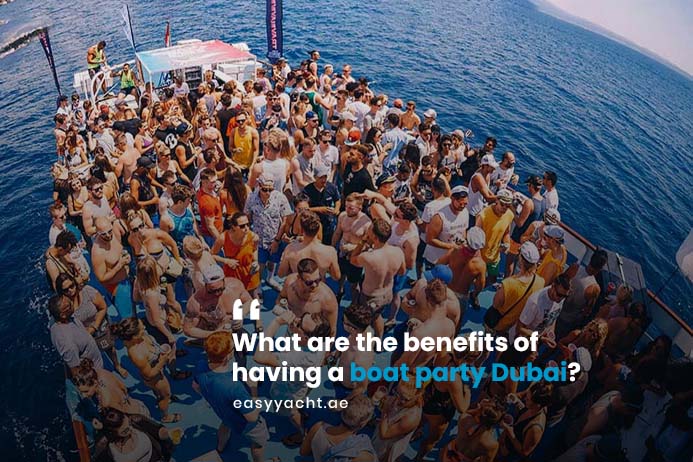
What are the benefits of having a boat party Dubai?

Top 10 best floating restaurant Dubai | 2023

Best 15 Places in Dubai Marina for breakfast (2024 Updated)

Need Details?
Feel free to contact for any kind of inquiry.
Guests 1 2 3 4 5 6 7 8 9 10 11 12 13 14 15 16 17 18 19 20 21 22 23 24 25 26 27 28 29 30 31 32 33 34 35 36 37 38 39 40 41 42 43 44 45 46 47 48 49 50 51 52 53 54 55 56 57 58 59 60 61 62 63 64 65 66 67 68 69 70 71 72 73 74 75 76 77 78 79 80 81 82 83 84 85 86 87 88 89 90 91 92 93 94 95 96 97 98 99 100
Start Time 12:00 AM 12:30 AM 1:00 AM 1:30 AM 2:00 AM 2:30 AM 3:00 AM 3:30 AM 4:00 AM 4:30 AM 5:00 AM 5:30 AM 6:00 AM 6:30 AM 7:00 AM 7:30 AM 8:00 AM 8:30 AM 9:00 AM 9:30 AM 10:00 AM 10:30 AM 11:00 AM 11:30 AM 12:00 PM 12:30 PM 1:00 PM 1:30 PM 2:00 PM 2:30 PM 3:00 PM 3:30 PM 4:00 PM 4:30 PM 5:00 PM 5:30 PM 6:00 PM 6:30 PM 7:00 PM 7:30 PM 8:00 PM 8:30 PM 9:00 PM 9:30 PM 10:00 PM 10:30 PM 11:00 PM 11:30 PM


Service Locator
- Angler Endorsement
- Boat Towing Coverage
- Mechanical Breakdown
- Insurance Requirements in Mexico
- Agreed Hull Value
- Actual Cash Value
- Liability Only
- Insurance Payment Options
- Claims Information
- Towing Service Agreement
- Membership Plans
- Boat Show Tickets
- BoatUS Boats For Sale
- Membership Payment Options
- Consumer Affairs
- Boat Documentation Requirements
- Installation Instructions
- Shipping & Handling Information
- Contact Boat Lettering
- End User Agreement
- Frequently Asked Questions
- Vessel Documentation
- BoatUS Foundation
- Government Affairs
- Powercruisers
- Buying & Selling Advice
- Maintenance
- Tow Vehicles
- Make & Create
- Makeovers & Refitting
- Accessories
- Electronics
- Skills, Tips, Tools
- Spring Preparation
- Winterization
- Boaters’ Rights
- Environment & Clean Water
- Boat Safety
- Navigational Hazards
- Personal Safety
- Batteries & Onboard Power
- Motors, Engines, Propulsion
- Books & Movies
- Cockpit Confessions
- Communication & Etiquette
- Contests & Sweepstakes
- Colleges & Tech Schools
- Food, Drink, Entertainment
- New To Boating
- Travel & Destinations
- Watersports
- Anchors & Anchoring
- Boat Handling
What "NMMA-Certified" Really Means
Advertisement
When shopping for a new boat, there's one sticker that matters more than the rest. Here's how a boat earns the "NMMA-Certified" logo, and what it means to you.
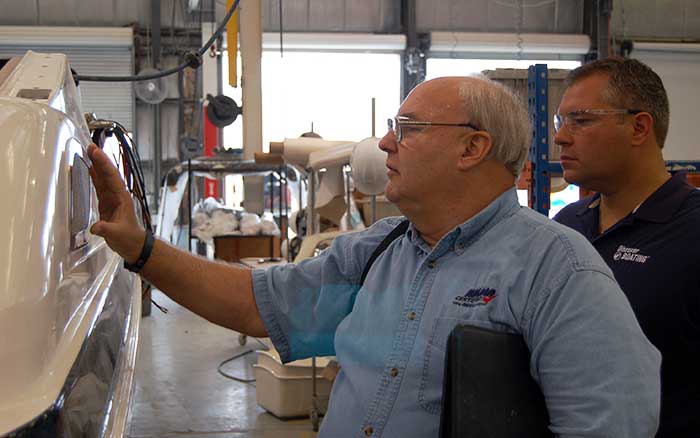
NMMA inspector Steve Carrier examines the engine air intake of a boat under construction.
New boats sport a lot of stickers. some warn about the hazards of carbon monoxide, others remind you of the prohibitions on discharging waste or oil. but if you're shopping for a new boat this spring, one to look for says "NMMA-certified using ABYC standards." alphabet soup aside, this means that someone with an enormously deep fund of knowledge about boatbuilding has inspected this model of boat at different times during its building process and deemed it built to standards developed by the industry to ensure a high degree of safety.
This past fall, BoatUS spent time with independent inspector Steve Carrier, who reports to the National Marine Manufacturers Association (NMMA), during a visit to Regal Boats in Orlando, Florida, a boatbuilding company that has paid to go through the rigorous process of NMMA certification.
Wait, Aren't Inspections the Coast Guard's Job?
Unlike for cars or airplanes, there are relatively few federal regulations regarding the construction of boats. Sure, the Coast Guard has rules regarding flotation and stability, plus engine-ventilation requirements for gas inboards, but these have little to do with how a boat is built and more to do with meeting minimal safety requirements. As a matter of fact, if your boat measures longer than 20 feet and sports diesel power, there are virtually no federal regulations that apply to its construction.
On boats 26 feet and less, look for the "NMMA-Certified" logo on the capacity plate. Larger boats should have a separate "Yacht Certified" plate aboard.
The federal government doesn't dictate how far away a steering wheel should be from a throttle lever, or how much of the view through a windshield can be obscured by supports, or any of the dozens of other safety considerations. Boatbuilding is largely self-regulated.
To ensure that boating remains safe and enjoyable — and to make it unnecessary for government to step in — the boatbuilders had to come up with an effective way to police them-selves at a high standard.
Standards + Certification
Boats are paradoxical vehicles in that, largely in pursuit of pleasure and at considerable expense, we buy them in order to drive them into a challenging environment. We take for granted that much of the responsibility for getting safely home lies on our shoulders and on our practice of good seamanship, and we put our trust in our vessels that they won't let us down when we need them. The American Boat and Yacht Council (ABYC) strives to make sure that a boat's construction is not at fault if something does not go according to our plan out there. "It's our industry following the lead of so many other industries, and self-regulating rather than being subject to far-reaching and unchangeable federal regulations," says John Adey, president of ABYC (and one of our own BoatUS Magazine contributing editors).
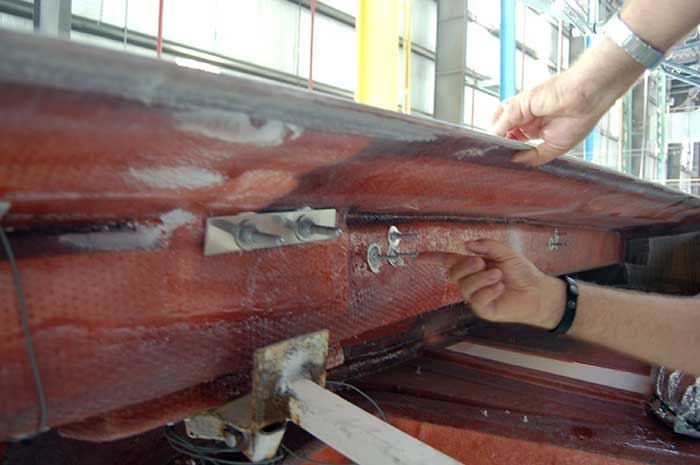
With the deck cap off, backing plates can be examined for hard-point attachments such as cleats.
Founded in 1954, the ABYC today is made up of more than 400 volunteers who serve on the committees that author the standards, plus a small, dedicated full-time staff. Each committee, known as a technical working group, digs deep into one standard, each of which is reviewed on either a three- or five-year cycle. The groups can be anywhere from 14 to 45 members strong, made up of a balance of boaters, boatbuilders, marine surveyors, government agencies, accessory manufacturers, insurance-industry experts, and some BoatUS staff.
Through these technical working groups, ABYC has written 58 standards, each of which touches on a different aspect of boatbuilding. The overall focus of each standard is safety, regardless of whether it applies to internal fuel tankage or the boat's horn. Collectively, the most recent edition of the standards total 1,152 pages. This phonebook-sized compendium of recommendations is available to all boatbuilders for the cost of ABYC membership, but it is completely optional. It's up to the builder to decide whether or not to follow these standards unless the builder happens to be a member of the NMMA.
In 2003, the NMMA and ABYC joined forces when the NMMA decided to start enforcing ABYC standards through their certification process. Prior to that, the NMMA relied on their own standards, similar to the ABYC's. Now, NMMA's boatbuilder members are required to participate in the certification process. Thanks to their efforts, more than 180 boatbuilders now build to the standards, and NMMA reports that around 85 percent of the boats sold in the U.S. today are certified.
Top To Bottom
The certification process starts with designating someone at the boatbuilding plant as the point person for the venture — a significant role. That person is responsible for knowing all 58 of the standards, inside and out, and for educating the builder's workforce how to comply. The NMMA makes this easier by hosting annual training seminars on the standards, taught by NMMA and ABYC staff, the independent inspectors that travel to each plant, and other industry experts. At the end, there's an open-book test that challenges the builder's rep to apply the standard to real-world boatbuilding examples. "The inspectors have been authoring the exams," says Carrier, an independent inspector hired by the NMMA to inspect boats for certification. "Test takers must dig into the standards and think."
"One of our jobs is to help boatbuilders evolve and comply with the standards," says Robert Newsome, NMMA director of engineering standards. "It typically takes 40 to 50 hours annually to study for and take the compliance exam." The next step is to submit a master list of all the boat models the builder plans to make in the coming model year. New models — or if the boatbuilder is just beginning participation in the certification program — must be scrutinized onsite by a certification inspector.
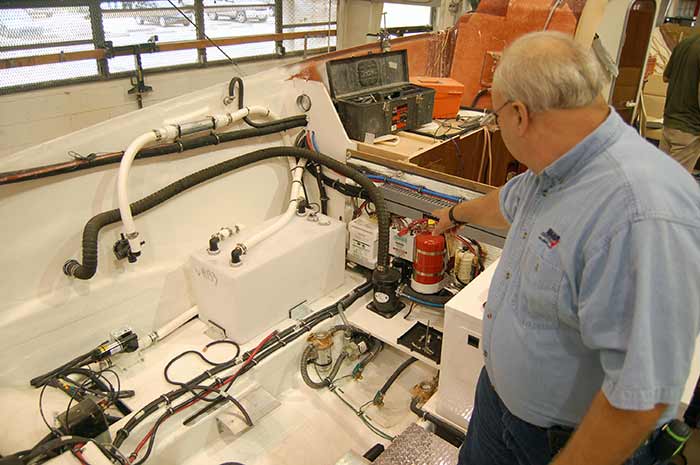
Carrier points out key elements of a proper generator installation and an enclosed cable run (in gray) that keeps the engine room neat and the wires protected.
During our inspection demonstration at Regal, Carrier showed us how he inspects a boat for compliance, moving from partially completed boats to finished boats, pointing out areas of interest along the way. The list of items he scrutinized seemed endless. The standards set everything from the minimum distance between supports for wire runs and hoses, to checking for the presence of a charcoal-filled fuel-vent vapor filter, part of the recently adopted fuel-fill and evaporative emissions standards. With the decks still off a cruiser, we could inspect the backing plates for cleats and wiring for shore power, and see the surface area of an engine-ventilation intake. Inside the hull, the back sides of cabinetry was exposed, revealing wire runs, ductwork for air conditioning, and freshwater hoses.
At one point at Regal, we inspected a midsize cruiser without engines installed. The empty engine bay gave Carrier a chance to look at how other systems had been installed including the generator and its exhaust run, which according to the standards should exit the boat as close to the stern as is practical.
A glance at the fuel system told Carrier whether the boat was destined for diesel or gas sterndrives, which further defined the list of items he had to examine. Carrier knew the standards inside and out, and also carried a condensed version in a notebook. When a question arose about the exact placement of a gas fume detector in an engine compartment, he quickly found the answer (a few inches above the high-water alarm level in the bilge).
Throughout the inspection, Carrier gave notes to Dennis Reis, Regal's head of engineering and one of two people at Regal responsible for compliance. In certificationspeak, any deviation from the standard would be a "variance" and trigger a followup. At the end of the inspection, the inspector turns in a written report within a week listing any variances found. The builder then has 30 days to respond to the NMMA with a corrective action plan for each item. For production-based variances — for example insufficient supports on a hose run, or too many wires on a fuse block — educating the worker tasked with the assembly of those components about the correct process might be all that is required.
"The majority of variance issues that turn up are production-based for a builder continuing in the program," says Newsome. For engineering-based variances, where something was designed in a manner inconsistent with the standards, testing or reengineering the part may be required, as well as photo documentation during follow-up.
Complying with these constantly updated standards for each new model seems like a gargantuan task, but there are ways to keep compliance from being overwhelming. For instance, boatbuilders rely on numerous vendors to supply boat parts; everything from cleats and thru-hulls to fuel tanks and horns comes from outside suppliers. Some items are critical components, such as fuel tanks, and require additional scrutiny in the form of standards from other organizations such as Underwriters Laboratory (UL), or the National Fire Protection Association (NFPA).
The NMMA compiles a list of those that meet the requirements, deems them "type-accepted," and allows builders to use such components without further testing.
Boating Benefits
Builders that are not NMMA members may still build to ABYC standards, but they are not inspected, or certified. Adey says many low-volume builders do their best to comply and build to the standards. Smaller builders do so knowing that the ABYC standards exceed the minimum requirements of the federal government.
Used-boat buyers can look for the "NMMA-Certified using ABYC standards" logo on the capacity plate of boats measuring 26 feet or less, or look for a "Yacht Certified" plate, typically metal and permanently affixed, if the boat is longer than 26 feet. This indicates the boat was certified to the standards in effect at the time of construction; however, any repairs or changes made by a prior owner may or may not have been made according to ABYC recommendations.
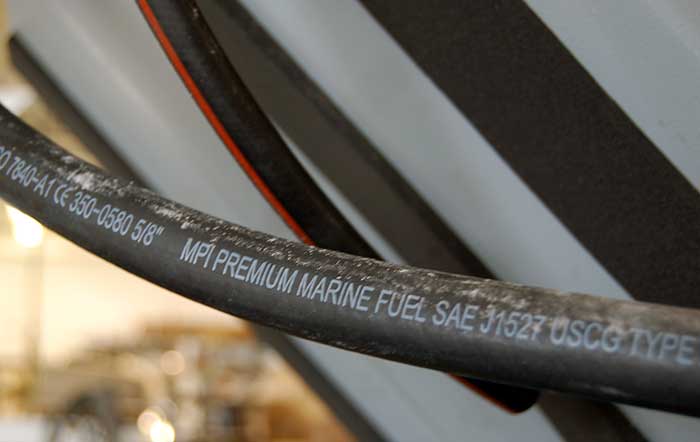
Some types of equipment may be approved by standards other than the NMMA's such as those of organizations like the Society of Automotive Engineers (SAE) or the Coast Guard.
Manufacturers that go to the added trouble and expense to build their boats to ABYC standards and participate in the NMMA certification process are proud of it and view the certification visits as learning opportunities, where they can improve the boatbuilding process and their products. And though building to the standards can increase the cost of doing business — for instance, the recently adopted fuel-fill and evaporative emissions standard effectively raised the cost of a fuel tank by as much as 300 percent — the builders believe the alternative, regulations written by federal agencies, would be far more onerous.
Related Articles
The truth about ceramic coatings for boats.
Our editor investigates the marketing claims of consumer-grade ceramic coatings.
Fine-Tune Your Side Scan Fishfinder
Take your side-scanning fishfinder off auto mode, and you’ll be spotting your prey from afar in no time
DIY Boat Foam Decking
Closed-cell foam flooring helps make boating more comfortable. Here’s how to install it on your vessel
Click to explore related articles
Michael Vatalaro
Contributor, BoatUS Magazine
Michael Vatalaro is the former executive editor of BoatUS Magazine. He has a Pursuit center console, which he uses in the Chesapeake Bay.
BoatUS Magazine Is A Benefit Of BoatUS Membership
Membership Benefits Include:
Subscription to the print version of BoatUS Magazine
4% back on purchases from West Marine stores or online at WestMarine.com
Discounts on fuel, transient slips, repairs and more at over 1,200 businesses
Deals on cruises, charters, car rentals, hotel stays and more…
All for only $25/year!
We use cookies to enhance your visit to our website and to improve your experience. By continuing to use our website, you’re agreeing to our cookie policy.

CE Yacht Compliance Classification
29 March 2016
The CE Yacht Compliance Classification System is the European (CE stands for “ Conformité Européenne ” in French) dictating the standards for CE Certification for construction and sale of boats . Vessels in one of the categories of controlled products cannot be legally sold in the EU unless they have passed the tests to receive the CE Certification. This regulation applies to all yachts for sale and recreational craft from 2.5 to 24 meters, whether they are intended for navigation at sea or in inland waters. New or used boats coming from countries other than the Member States of the European Union are also subject to CE marking.
In 1994, the countries in the European Union adopted the Recreational Craft Directive (RCD), which they amended in 2003. This constitutes a single set of “harmonized” essential requirements for boats sold in any member country.
The compliance with the RCD is required by law in the European Union member countries, and third-party classification societies inspections and their certifications are required as part of the process of CE yacht compliance classification. Boats are given a CE certification at the end of the process, which confirms that they have passed and comply with the technical, construction, safety and legal requirements making them legally valid for sale in the European Union. In Europe, we call them commonly “CE compliant boats” .
CE certification required
Summary of the origin and CE yacht compliant classification and how certification works.
Since 1998, European legislation indicates that pleasure boats must carry the CE certification (or mark), requiring them to meet certain construction and safety standards. For this, the boats are classified into four categories according to their design and skills to face different sailing conditions depending on the wind force and wave height.
Knowing that the weather is a variable phenomenon, these categories are not intended to limit the distance boaters can sail away (this depends on onboard safety equipment), but rather to responsibly inform them about the capabilities of their boat to safely navigate based on the offshore weather conditions. For each vessel, the design category is characterized by a letter between A and D.
BEAUFORT scale
First, let’s start with the BEAUFORT scale. This scale gives you the status of the sea in order to plan your trips. It was the British admiral Francis BEAUFORT who imagined a scale with sufficiently precise criteria to quantify the wind at sea and allow the divulgation of reliable information universally understood. This scale consists of 13 degrees, from 0 to 12, which is remarkable in this scale is that it can assess the effect of wind on the surface of the sea.
We will focus on the scale with the forces of 6, 7 and 8 to our need for explanations. There is indeed a direct link between the Beaufort scale and the certification of yachts (see photo above of the scale to better understand the graduation of wind forces).
- CE CLASS A yachts are designed for large sea voyages (everywhere), in which wind force may exceed 8 on the scale of BEAUFORT and waves can also exceed a significant height of 4 meters. These yachts are designed largely to be self-sufficient in this rather hostile environment. CAREFUL, in most cases, this is only theoretical.
- CE CLASS B yachts are designed to travel off the coast (200 miles or less) in which the winds can be up to force 8 (not exceeding) and waves can reach a height up to 4 meters (not exceeding).
- CE CLASS C boats are designed for travel close to the coasts and in large bays, estuaries, lakes and rivers in which winds can be up to force 6 (not exceeding) and waves may reach a height of 2 meters (not exceeding).
- CE CLASS D boats are designed for cruises in protected waters, like small lakes, rivers and canals in which the winds can be up to force 4 and waves can reach a height up to 0.30 meter (less than 1 foot).
Rules of CE certification
The rules of CE certification for construction and sale of boats are designed to assess the structural strength and integrity of essential parts of the hull, the reliability, and function of propulsion, steering systems, power generation and all other features installed on board to help ensure the key essential services of the yacht.
You understand therefore that a CLASS A yacht respects a much more rigorous construction protocol than a CLASS B yacht and so on… Of course, it is strictly advised not to sail past a force 6 for pleasure yachting and no matter the class A or B. This is a matter of safety, comfort and pleasure being always present in your cruise.
To ensure recreational boating, always check the weather before each ride at sea and especially verify any potential changes every hour. In addition, you must always carry the safety equipment onboard depending on the type of navigation that you practice and the laws and regulations in the countries where you cruise, and feel free to be overcautious.
It is obvious that in case of bad weather, for example, it is better to find yourself onboard a CLASS A yacht, which will necessarily have a better safety margin, regardless of sea conditions… Before buying a new or pre-owned boat , always ask for the classification of your future yacht, this document is required for the new registration (in Europe).
A CE-Type Certificate (or homologation) is generally issued for production vessels manufactured in series by different shipyards , particularly European.
There are several classification societies capable of achieving the CE classification for construction and sale of boats , the main ones are RINA (Registro Italiano Navale), BV (Bureau Veritas), DNV (Det Norske Veritas), Germanischer Lloyd, LR (Lloyd’s Register).
Other societies and certifications
There are also other classification societies for vessels built or sold outside the EU such as ABS (American Bureau of Shipping) and NK (Nippon Kaiji). There are also other types of certifications such as the MCA (UK – Maritime and Coastguard Agency), which however is not a classification organization. We will write more articles on commercial classifications later.
Do not hesitate to contact us for any need for further information on the CE yacht compliance classification , our team at Allied Yachting is at your service.
Contact us if you have more questions
Your Name (required)
Your Email (required)
Please leave this field empty.
Your Phone (required)
Your Message
Our Yacht Listings:
- New Yachts for Sale
- Pre-owned Yachts for Sale
- Yachts for Charter
You might also like

Yachting Consultants
Sale-Charter-Brokerage-Management
Headquarters:
34 Rue Caffarelli 06000 Nice, France
Front Office:
Boulevard de La Croisette – Port Canto 06400 Cannes, France
T.: +33 493 43 82 83 Email: [email protected] Website: www.alliedyachting.com

The Sterndrive Class is great for embarking on a full array of day boat activities. From the 20’ foot runabout for inland lakes to the roomy 36’ luxury cruiser that handles big water, you’ll find a great choice among our Sterndrive Class for doing it all on the water.
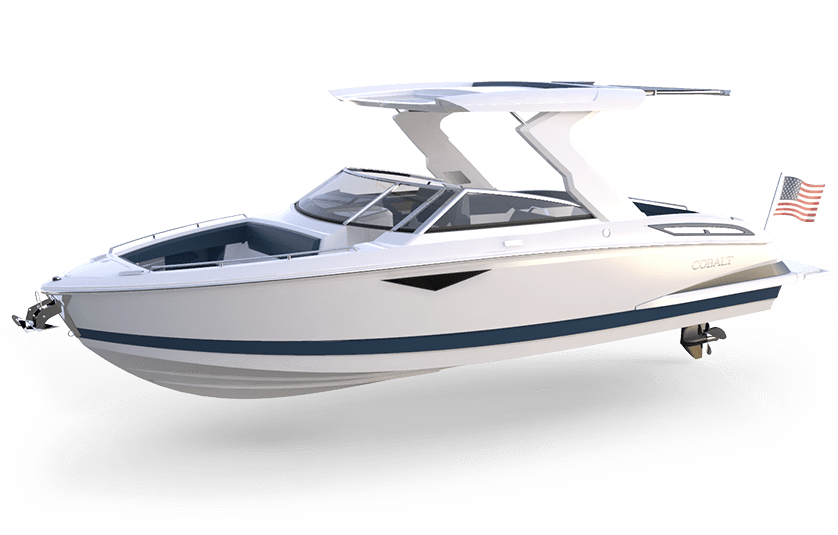
- Day Cruising
- Wakeboarding
- At Anchor In-Water Activity
- Large Bodies of Water
- Small Bodies of Water
- Overnight Aboard
For those who want all the versatility of a sterndrive with enhanced surf boat capabilities, the Surf Class is the perfect choice. In three easy steps, you’ll have the ideal wave for your family’s surfing success. And all of this with no trade-offs in your cruising enjoyment.
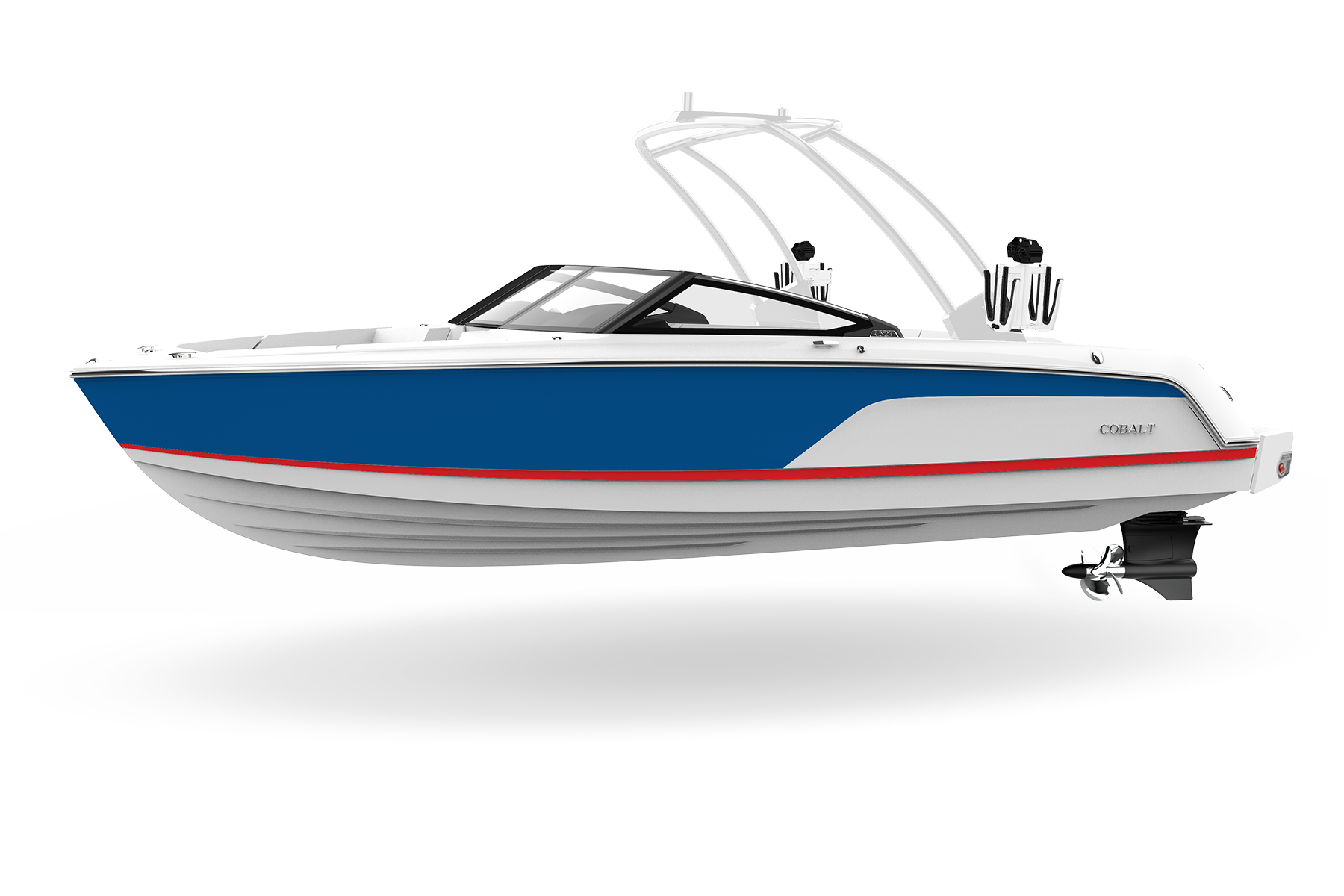
The Outboard Class offers powerful cruising with a modern quiet ride. Great in saltwater, these outboard boats are engineered for efficiency, ease of maintenance, and year-round readiness with a variety of power options.
The Coastal Edition is designed with a comprehensive set of features specifically tailored for saltwater protection and durability. Boaters can navigate with confidence, knowing that the boat is equipped to handle the elements effectively.
Our Coastal Edition features the highest quality stainless steel components, watertight electrical connectors, innovative water management system, GPS mapping with coastal maps, carpet-free floor storage, redundant bilge pump system, and self-bailing cockpit (R6 models and above).
- Outboard Class

- Explore All
- Owner Experiences
- Cobalt Innovations
- Coastal Edition
- Monsoon Engines
- News & Events
- Our Company

- Design Your Dream
- Find a Dealer
- Full Line Brochure Request
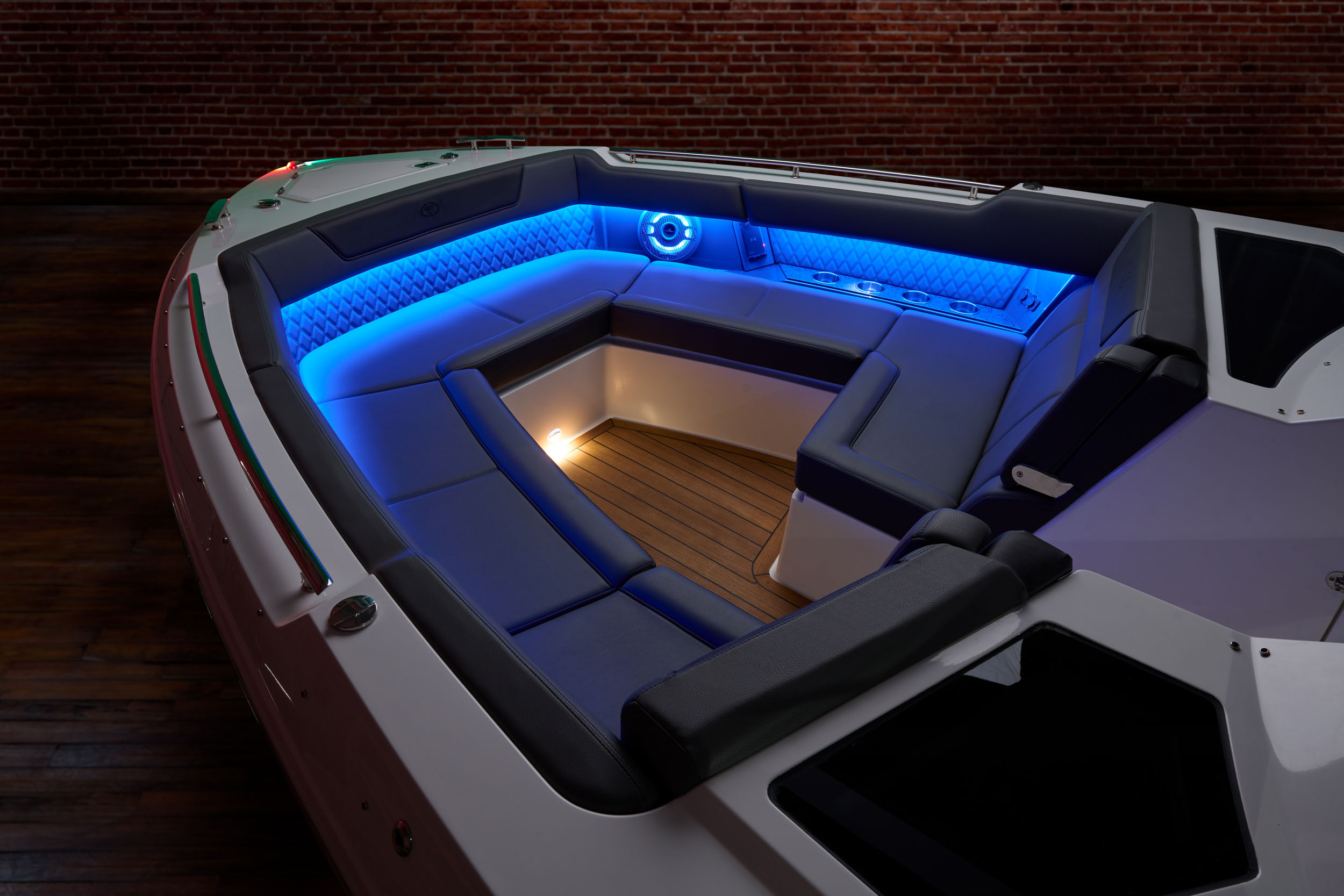
Yacht Certification
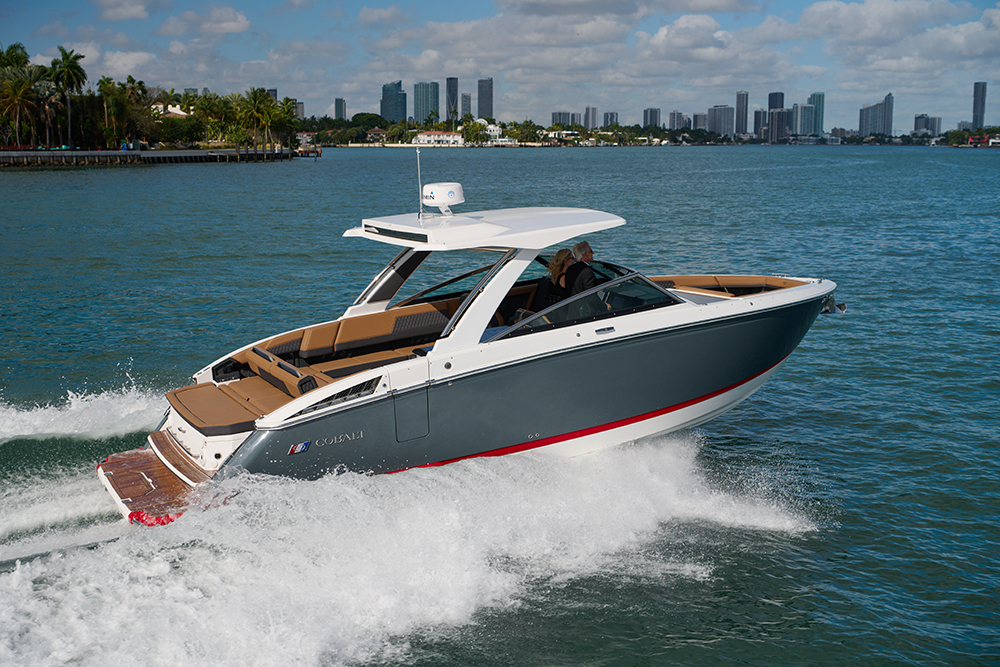
Is It Only About Size?
Did you ever wonder at the term ‘Yacht Certified’ when you see it listed in the ‘Capacity’ category for many Cobalt boats? If so, here’s what it’s really about, and it goes way beyond the number of people a boat can carry safely.
Boats, Yachts, and Ships
First, let’s start with the definition of a yacht, which is often described as a boat that’s 35 feet or more in length. At the extreme, a yacht can range in size to more than 200 feet, which also brings up the discussion of the difference between a boat and a ship (fun fact: the definition of a boat is that it leans into a turn, while ships heel outward in a turn.)
For our purposes, though, the term ‘yacht’ as used by the National Marine Manufacturing Association (NMMA) refers to boats that are 26 ft. or longer, which gets to the heart of why a pleasure-boat owner might want to know what goes into their yacht certification.
How the Yacht-Certified Placard Benefits You
“Yacht Certification” is a manufacturing quality standard implemented by the NMMA under a vetting process established by the American Boats & Yacht Council. The advantage of this for boat buyers – including Cobalt owners, of course, since every yacht-certified Cobalt model goes through NMMA recertification each year – is that many boat manufacturing processes are tested and inspected during manufacturing by a trained representative of a neutral, independent certifying body.
Comprising a physical inspection of critical safety items, from bilge pumps to fuel tanks, horns, lights and steering components, yacht certification shows that a manufacturer is committed to meeting and exceeding a higher quality standard.
The Comforts of Consistency
One immediate benefit of yacht certification is, of course, knowing these boats don’t have a defined passenger capacity. But there are other comforts of having a consistent set of certification standards.
Such as the fact that there are thousands of trained technicians who develop and oversee these tests, helping to ensure that any manufacturing issues can be immediately identified and resolved on the factory floor. Or that yacht-certified boats are 7 times less likely to experience a safety recall. Or that the yacht-certification program provides boat manufacturers with an established structure for tracking the customer experience, as well as participating in the Marine Industry Customer Satisfaction Awards Program.
Built To A Higher Standard
In short, yacht certification is another way to ensure that Cobalt boats are built to the highest industry standards, so Cobalt owners can enjoy the level of superior, consistent quality that they – and we – expect.

If you’re interested in learning more about boatbuilding, we’re ready to help! Contact us with your question and we’ll be glad to share the answers with your fellow Cobalt owners!
Related Posts
Ita Yachts Canada
Brokerage / Courtage
Demystifying yacht classification A, B, C, D
N.B. For your information, a more recent article was published on 24 Oct 2022 on the same subject, click here for direct access.

Demystifying yacht classification : Class A, B, C and D
Since 1998, CE certification is required for all recreational boats entering or being sold in Europe obliging boat manufacturers to respect certain building and security standards. Therefore, yachts ( boats ) are classified into four categories depending on their aptitude to confront navigational conditions taking into account both force of the wind and height of the waves. The categories are not to limit the area and distance of navigation (that is defined by security equipement onboard) but to sensitize the owner and/or captain of the boats capacities to navigate in complete security.
Let us start with the Beaufort Scale. A scale for classifying the force of the wind ranging from 0 (calm) to 12 (hurricane). It was devised by an admiral in the British Navy, Francis Beaufort, to uniform the description of the effect of different winds at sea.
There is a direct link between the Beaufort scale and boat classification. For discussion purposes, we will use only the 6, 7 and 8 forces.
A Class A yacht ( boat ) is a vessel that is built to navigate the open ocean and surpass a force 8 on the Beaufort scale and surpass waves higher that 4 meters. These yachts are constructed to be self sufficient in hostile seas.
A Class B yacht ( boat ) is a vessel built to navigate on the offshore waters (200 miles and less) and can substain UP TO force 8 and waves UP TO 4 meters.
A Class C boat is a vessel built to navigate inshore such as lakes, rivers, bays and close to the shore and can sustain UP TO force 6 and waves UP TO 2 meters.
A Class D boat is built for protected or sheltered waters such as canals, rivers, small lakes and sustain a force 4 and waves UP TO .3 meters (less that 1 ft).
With this said, you can understand that the Class A yacht ( boat ) respects a rigorous building code more so than a Class B and so forth. But regardless of the class, it is strongly discouraged to navigate in a force 7 for the reasons of safety and comfort as « pleasure » should always be on the agenda. Always consult the weather forecast prior to leaving any port and check hourly the weather situation.
Classification is very important and should be on your question list before purchasing any boat or yacht.
Classification rules are developed to assess the structural strength and integrity of the essential parts of the hull, the reliability and function of the propulsion, steering systems, power generation and all the other features installed on board which contribute to guarantee the main essential services of yacht.
Also for a class A, the portholes will be more resistant against a sustained wave, the drains to evacuate the water more abundant and of good size, the joints of the hull more hermetic, in short everything is in place to prevent water from s’ infiltrate on board.
By way of information, let us quote for example all the Ferretti yachts (60 to 96 feet), Pershing (60 to 115), the Riva (44 to 122) are all of class A just like the Magellano range at Azimut including also the 66 Flybridge.
Ferretti yachts (500, 550, 670 fly and over), Pershing (7X and over), Azimut Yachts (62, 64, 66, 68 Fly and over, the Sport Series 7X and over, all Magellano) are Class A. There are also other classifications such as RINA and American Bureau of Shipping, Bureau Veritas, Det Norske Veritas, Germanischer Lloyd, Lloyd Register, that are more precise regulations and we will cover this later in another article.
Below is the graph of the Beaufort Scale along with photos.
Do not hesitate to contact us for any additional information, team Ita Yachts Canada is at your disposal.

Share this:
Published by Guy Bolduc
View all posts by Guy Bolduc
Leave a Reply Cancel reply
Discover more from ita yachts canada.
Subscribe now to keep reading and get access to the full archive.
Type your email…
Continue reading
- CATAMARAN MOTEUR
- CATAMARAN VOILE
- CENTER CONSOLE
- FISHING BOAT
- SPORT BRIDGE
- ABSOLUTE YACHTS
- CRUISERS YACHTS
- FOUNTAINE PAJOT
- GRAND BANKS
- KADEY-KROGEN
- MOCHI CRAFT
- MINIGHT EXPRESS
- MONTE CARLO
- NORTHERN MARINE
- OCEAN ALEXANDER
- OUTBACK YATCHS
- PARDO YACHTS
- PRESTIGE YACHTS
- SILENT YACHTS
- $1,5 M to $2,9 M
- $3,0 M to $4,9 M
- $5,0 M to $6,9 M
- $7,0 M to $9,9 M
- $10,0 M and more
- UNDER 49 FEET
- 50 to 59 FEET
- 60 to 69 FEET
- 70 to 79 FEET
- 80 to 89 FEET
- 90 to 99 FEET
- MORE THAN 100 FEET
- CENTRAL AMERICA
- PERSIAN GULF
- UNITED-STATES OF AMERICA
- YACHTS REGISTERED UPDATED
- VIRTUAL TOUR 3D
- YACHTS FOR SALE
- IMPORT-EXPORT
- BLOGUES, NOUVELLES ET CONSEILS
- PODCAST VIDEO
- New Sailboats
- Sailboats 21-30ft
- Sailboats 31-35ft
- Sailboats 36-40ft
- Sailboats Over 40ft
- Sailboats Under 21feet
- used_sailboats
- Apps and Computer Programs
- Communications
- Fishfinders
- Handheld Electronics
- Plotters MFDS Rradar
- Wind, Speed & Depth Instruments
- Anchoring Mooring
- Running Rigging
- Sails Canvas
- Standing Rigging
- Diesel Engines
- Off Grid Energy
- Cleaning Waxing
- DIY Projects
- Repair, Tools & Materials
- Spare Parts
- Tools & Gadgets
- Cabin Comfort
- Ventilation
- Footwear Apparel
- Foul Weather Gear
- Mailport & PS Advisor
- Inside Practical Sailor Blog
- Activate My Web Access
- Reset Password
- Customer Service

- Free Newsletter

Catalina 270 vs. The Beneteau First 265 Used Boat Match-Up

Ericson 41 Used Boat Review

Mason 33 Used Boat Review


Beneteau 311, Catalina 310 and Hunter 326 Used Boat Comparison

Tips From A First “Sail” on the ICW

Tillerpilot Tips and Safety Cautions

Best Crimpers and Strippers for Fixing Marine Electrical Connectors

Thinking Through a Solar Power Installation

Polyester vs. Nylon Rode

Getting the Most Out of Older Sails

How (Not) to Tie Your Boat to a Dock

Stopping Mainsheet Twist

Fuel Lift Pump: Easy DIY Diesel Fuel System Diagnostic and Repair

Ensuring Safe Shorepower

Sinking? Check Your Stuffing Box

The Rain Catcher’s Guide

What Do You Do With Old Fiberglass Boats?

Boat Repairs for the Technically Illiterate

Boat Maintenance for the Technically Illiterate: Part 1

Whats the Best Way to Restore Clear Plastic Windows?

Giving Bugs the Big Goodbye

Galley Gadgets for the Cruising Sailor

Those Extras you Don’t Need But Love to Have

What’s the Best Sunscreen?

UV Clothing: Is It Worth the Hype?

Preparing Yourself for Solo Sailing

How to Select Crew for a Passage or Delivery

R. Tucker Thompson Tall Ship Youth Voyage

On Watch: This 60-Year-Old Hinckley Pilot 35 is Also a Working…

On Watch: America’s Cup

On Watch: All Eyes on Europe Sail Racing

Dear Readers
- Sailboat Reviews
Certifications and Ratings: What’s the Deal?

The acronyms alone are enough to drive you nuts: ABYC, ISO, IMCI, ABS, NMMA. And those with real names, what are they: Germanischer Lloyd, Lloyds Register, Bureau Veritas?
One suspects that these whatever-they-ares have something to do with the way boats are built, or not built, but beyond that, it’s well, vague. Readers wonder, and so do we.

The United States Let’s start on our home turf. The dominant trade group in the U.S. is the National Marine Manufacturers Association (NMMA). It has offices in New York and Chicago. The NMMA represents nearly all businesses in the marine sector: boatbuilders, engine makers, and suppliers of accessories. A dozen years ago, during a bad financial phase for the boating industry in general, manufacturers of sailboats and sailing equipment weren’t happy with the way the NMMA represented them; after all, sailing is a small percentage of the boating industry. So a bunch of executives from the sailing realm (Frank Butler, Catalina; Everett Pearson, TPI; and John Southam, Cruising World magazine) started an association called ASAP that eventually came to be called Sail America. Sail America started running its own boat shows, called Sail Expos, and still does. But it was evident that the efforts of Sail America and the NMMA were to an extent redundant, so they have recently buried the hatchet and agreed to again share the same teepee.
Neither the NMMA nor Sail America promulgates standards for the construction or outfitting of boats. However, the NMMA has been vigorous in supporting ISO boatbuilding standards, which we’ll get to shortly.
For a time, the American Bureau of Shipping (ABS) attempted to develop standards for the construction of small fiberglass (composite) recreational boats. These standards actually included scan’tlings, but so many people in the industry criticized them as unrealistic that ABS retreated. Now, it offers only publication #37, “Building and Classing Offshore Racing Yachts,” which applies only to racing boats over 24 meters, or about 79 feet.
The ABS, like European classification societies, makes its money developing rules for building ships and other marine structures (like offshore oil platforms), and related equipment; then by reviewing the designers’ and builders’ plans, and sometimes by surveying the actual structure to assure compliance (often for insurance companies and lending institutions).
The Plan Review for a composite boat requires the submission of laminate schedules, information about the resins and reinforcements (fibers) and construction details. Many classification organizations also offer engineering services to companies to help them gain compliance. It’s a pretty nifty business plan: Make up a bunch of rules, then charge companies big fees to tell them how to comply.
The top classification is A1 with a Maltese cross; this means the classification society has reviewed the plans and observed the construction process. An A1 plan means the plans were reviewed for compliance with the rules, but no one from the classification society watched the construction take place.
For vessels built to class, such organizations may also conduct periodic surveys so that the vessel can “maintain class.”
The U.S. standard-setting organization that deals with recreational boats is the American Boat & Yacht Council (ABYC), which publishes “Standards and Technical Information Reports for Small Craft.” It’s a democratic sort of society, inasmuch as each standard is written by a committee of industry experts—employees of boatbuilding firms; employees of ancillary companies, like makers of electrical wire, pumps, and motors; and members of the ABYC staff. ABYC members (Practical Sailor is one) have the opportunity to attend committee meetings and to comment on the proposed standards.
ABYC does not have standards for scan’tlings, that is, the structural requirements of a hull in metal (like the thickness of plating), wood (like the spacing of frames) or plastic (like how many layers of fiberglass must be used in a given hull or deck). Nor does ABYC rate boats for specific uses, such as sheltered water versus open ocean. Instead, ABYC largely concerns itself with safety issues: fuel systems, electrical systems, lightning protection, through-hull strength and installation, load capacities, etc.
Compliance with ABYC standards is voluntary. So where does ABYC get its clout? To a great degree, from the insurance companies, which generally require surveyors to judge boats against ABYC standards. So, if your surveyor finds your boat not in compliance with ABYC, your insurance company may deny coverage. The same goes for banks and other lending institutions, which may require a survey to ABYC standards before finalizing a loan.
Boats built in the U.S. don’t have to comply with European standards unless they are to be sold there.
There are a few other groups affecting recreational boats, however: The U.S. Coast Guard is vitally involved in a variety of safety issues, from PFDs to fuel and electrical systems, buoyancy, loading, etc. One can order from the USCG a 271-page booklet titled, “Rules and Regulations for Recreation Boats,” which, to quote the Coast Guard explanation, contains among other things, “information of defect notification, manufacturer certification of compliance, labeling, hull identification numbers, capacity, safe loading, safe powering, testing electrical systems, fuel systems, ventilation, personal flotation devices, visual distress signals, fire extinguishers, marine sanitation devices, accident reporting requirements and state numbering systems.”
ABYC prepares and sells five individual “Compliance Guides” to help marine businesses understand the above codes. The guides on flotation, ventilation, electrical systems, fuel systems and safe loading sell for $25 each.
The Society of Naval Architects and Marine Engineers (SNAME) publishes its Technical and Research Bulletin 2-23, “Guide for Quality Assured Fiberglass Reinforced Structures,” which defines the basic materials and outlines what it considers acceptable shop practices. This could be considered an adjunct to the ABYC systems standards.
The National Fire Protection Association (NFPA) similarly has rules germane to its interests. Like the ABYC, it’s interested in safe systems, not in rating recreational boats for various wind and weather conditions.
The Offshore Racing Council (ORC) has established certain requirements for yachts to compete in certain sanctioned races. Some of these deal with safety equipment, but the more interesting ones to prospective boatbuyers have to do with features like cockpit volume, portlight size, and lifeline height. You can get a copy from US Sailing ( www.ussailing.org ).
Some gear installed in boats probably will have been tested and/or certified by other more industrial outfits like the American Society for Testing and Materials (ASTM International), a voluntary standards organization, and the American National Standards Institute (ANSI), which is a “private, non-profit organization (501(c)3) that administers and coordinates the U.S. voluntary standardization and conformity assessment system. The Institute’s mission is to enhance both the global competitiveness of U.S. business and the U.S. quality of life by promoting and facilitating voluntary consensus standards and conformity assessment systems, and safeguarding their integrity.”
Gear that would be standardized according to ANSI might include anything from a sink drain to a screw to a switch. ANSI is, for example, the group that makes sure all household lightbulbs have the same thread.
Then there’s Underwriters Laboratories (UL)—but it doesn’t develop scan’tlings for pleasure boats either.
ISO This brings us to the International Organization for Standardization (ISO). The easiest way to present this organization is to quote from its own self-explanation, which actually makes pretty interesting reading:
The International Organization for Standardization (ISO) is a worldwide federation of national standards bodies from some 140 countries, one from each country.
ISO is a non-governmental organization established in 1947. The mission of ISO is to promote the development of standardization and related activities in the world with a view to facilitating the international exchange of goods and services, and to developing cooperation in the spheres of intellectual, scientific, technological, and economic activity.
ISO’s work results in international agreements which are published as International Standards.
The ISO Name: Many people will have noticed a seeming lack of correspondence between the official title when used in full, International Organization for Standardization, and the short form, ISO. Shouldn’t the acronym be “IOS”? Yes, if it were an acronym — which it is not.
In fact, “ISO” is a word, derived from the Greek isos, meaning “equal,” which is the root of the prefix “iso-” that occurs in a host of terms, such as “isometric” (of equal measure or dimensions) and “isonomy” (equality of laws, or of people before the law)…
Why is international standardization needed? The existence of non-harmonized standards for similar technologies in different countries or regions can contribute to so-called “technical barriers to trade.” Export-minded industries have long sensed the need to agree on world standards to help rationalize the international trading process. This was the origin of the establishment of ISO.
ISO goes on to list the main reasons for its existence: worldwide progress in trade liberalization; inter-penetration of sectors; worldwide communications systems; global standards for emerging technologies; and developing countries that benefit from a standardized infrastructure.
ISO 9000 and ISO 14000 in plain language: Both “ISO 9000” and “ISO 14000” are actually families of standards which are referred to under these generic titles for convenience. Both families consist of standards and guidelines relating to management systems, and related supporting standards on terminology and specific tools, such as auditing (the process of checking that the management system conforms to the standard).
ISO 9000 is primarily concerned with “quality management.” Like “beauty,” everyone may have his or her idea of what “quality” is. In plain language, the standardized definition of “quality” in ISO 9000 refers to all those features of a product (or service) which are required by the customer. “Quality management” means what the organization does to ensure that its products conform to the customer’s requirements.
ISO 14000 is primarily concerned with “environmental management.” In plain language, this means what the organization does to minimize harmful effects on the environment caused by its activities.
Both ISO 9000 and ISO 14000 concern the way an organization goes about its work, and not directly the result of this work. In other words, they both concern processes, and not products — at least, not directly.
As bureaucratic autobiographies go, this one at least makes an attempt to be clear. Unfortunately, the manner in which ISO standards actually impact boatbuilding practices is anything but straightforward, and this seems to be due to the myriad complicated economic relationships between European countries.

Let’s start with the European Economic Area (EEA), which is composed of 15 countries—Austria, Belgium, Denmark, Finland, France, Germany, Greece, Ireland, Italy, Luxembourg, the Netherlands, Portugal, Spain, Sweden and the United Kingdom; as well as three of four members of the European Free Trade Association: Iceland, Norway and Liechtenstein.
The EEA countries, as well as Switzerland, Tunisia, and Turkey, adopted something called the Recreational Craft Directive (RCD), which basically says that some set of standards must be met and provides a mechanism for making sure that boatbuilders and equipment manufacturers comply.
The RCD strongly urges that builders use ISO above other standards. Moreover, with few exceptions all boats—new and used—sold in Europe (which effectively encompasses all the countries belonging to the EEA) must be marked Conformité Européene (CE).
While builders of smaller boats can self-certify, a company building boats larger than 12 meters (roughly 39 feet) must apply for CE certification by showing its work to a “notified body,” which in the UK would include Lloyd’s Register; in France, Bureau Veritas; in Germany, Germanischer Lloyd; in Italy, Registro Italiano Navale (RINA); in Japan, Nippon Kaiji Kyokai; and in Norway, Det Norske Veritas.
There is also the Brussels, Belgium-based International Marine Certification Institute (IMCI), which was set up in part by the NMMA to aid U.S. builders. IMCI claims to have 60% of the certification business.
All of these outfits are akin to the ABS here in the U.S., and may be loosely called certification societies. This sort of implies that they are non-profit entities one step removed from government. This is not quite the case.
Here’s Germanischer Lloyd’s explanation of its “History and Corporate Form”:
In order to be able to assess ships’ quality and safety independently of outside interests, in 1867 Hanseatic shipowners and underwriters initiated the foundation of a classification society. Germanischer Lloyd was established in the form of a co-operative society. In 1899 the society was transformed into a joint-stock company having the character of a non-profit organization. Now as before, the 800 not freely transferable registered shares are owned by members of the shipping community (shipowners, shipyards, bankers and subcontractors). Subject to the company statutes, the shares may be transferred at par and with the Executive Board’s approval only.
Germanischer Lloyd has since developed from a classification society for ships into an engineering and inspection company operating worldwide. The object of the company is surveillance of safety and quality in the maritime sector.
Germanischer Lloyd is one of the leading classification societies worldwide. As an independent and impartial society GL supervises quality and safety mainly for ships and for maritime installations. Highly qualified engineers are operative worldwide at over 450 locations in more than 135 countries with major markets in Europe, the Americas and Asia.
So, yes, these societies are aggressively marketing themselves, and not to yacht owners, but to shipping magnates. Here’s the pitch from Lloyd’s Register:
We believe that our approach to classification is more dynamic than the traditional prescriptive approach. Applying our market-leading knowledge gained over many years, we can provide a robust framework for a risk-based approach to managing your fleet within the classification context. This enables you to incorporate effective risk management into your day-to-day business.
Lloyd’s Register has a number of standards to which builders can construct a yacht. The higher ratings require a Lloyd’s inspector to observe construction of the yacht at various phases to insure that the builder’s practices meet the rules. The cost of this inspection is inevitably passed along to his customer.
Have a look at the table below, “The Four Categories,” which defines various levels of seaworthiness that a builder can aim for. There are a number of ways in which a boatbuilder may have to get approval. Called “modules,” these range from “Internal production control” to “Conformity to Type” and “EC-type Examination,” which might work like this: Once a builder completes plans and engi neering details, and presumably builds the boat, he asks a “notified body,” such as IMCI, Lloyd’s Register, or Bureau Veritas, to examine his work and certify that the boat is indeed of the class claimed, such as B. OFFSHORE. The notified body determines whether the boat meets the applicable rules and either grants or denies certification. As we learned with the ill-fated attempt of ABS to write rules for small offshore sailboats, the standards applied by a notified body to a given boat may not be stringent or even reasonable. Here’s the RCD phraseology:
1. A notified body ascertains and attests that a specimen, representative of the production envisaged, meets the provisions of the Directive that apply to it.
And what, you may ask, are the applicable provisions? Here’s all the RCD says about structures:
3. INTEGRITY AND STRUCTURAL REQUIREMENTS 3.1. Structure The choice and combination of materials and its construction shall ensure that the craft is strong enough in all respects. Special attention shall be paid to the design category according to section 1, and the manufacturer’s maximum recommended load in accordance with section 3.6.
3.2. Stability and freeboard The craft shall have sufficient stability and freeboard considering its design category according to section 1 and the manufacturer’s maximum recommended load according to section 3.6.
Other requirements pertain to components like “Ignition-protected equipment for inboard and stern drive engines,” and “Steering wheels, steering mechanisms and cable assemblies.”(Interestingly, classification societies do not deal with the mast and rigging or sailplan.)
Note that no scan’tlings are specified. Therefore, if a builder claims his boats are A. OCEAN, and a “notified body” agrees that it conforms to applicable standards, then it is, at least according to the RCD and ISO (which is always in the background), a transoceanic-capable boat. But what does that mean? Here’s Hunter Marine’s statement on CE certification:
CE Certified boats are available for purchase in the United States, upon special order and for increased cost. As stated in our owners’ manuals, all CE Certified boats will carry a special CE plate, which will be attached to the boat. Boats that are destined for Europe or countries that require CE Certification will have this plate. Boats intended to be sold in the U. S. and most other areas will not carry the plate even though many aspects of the boat comply with the requirements. All hulls and decks are constructed to the same specifications whether they are to be CE Certified or not. The difference is in add-on accessories and different voltage appliances specified for certain countries.
This is a clear, non-glossy explanation of Hunter’s view of the benefits of CE certification (or lack thereof). It’s possible for builders to run that ball the other way, too, by making a bigger deal out of CE (or any other certification) than might be justified or necessary, simply to dazzle the customer.
ISO 12215 In any case, much of this is about to change. Scan’tlings from ISO are on the way. The standard, known as ISO 12215, is now in draft form and does specify minimum hull thicknesses.
At present there are 20 “harmonized” (meaning ratified by the governments of all countries) ISO standards for many boat systems, including steering, bilge pumps, seacocks, and electrical systems. Many more are in draft form—47 to be exact. These include not only scan’tlings for composites, metal, and wood, but others for stability and buoyancy. These, plus other standards, such as portlights, contain language that relates to the four categories of general seaworthiness mentioned above.
So… What Does It It All Mean? In the U.S., all that really counts is compliance with the US Coast Guard’s rules and the ABYC’s “Standards and Technical Information Reports for Small Craft.” Compliance may be necessary for insuring the vessel. But compliance should not imply that a given boat is suitable for a given set of conditions—and that’s what a lot of people want to know: Is my boat safe to take offshore?
Most of ABYC’s standards are sensible and should be incorporated in any boat, be it a sheltered-water runabout or round-the-world ketch. Many ISO standards were drawn from the ABYC and USCG and, if not identical, are generally of similar intent.
ABYC, however, does not promulgate scan’tlings such as fiberglass laminate thickness or design elements such as draft, beam-length ratios, etc. You could build a fiberglass tub an inch thick that wouldn’t be seaworthy, or a thin-skinned boat so intelligently conceived and engineered that it could survive falling off monster waves. And what of the skipper and crew? In extreme conditions the survivability of any boat is largely dependent on the skills of its crew. How do you write any of these elements into a rule?
The Bottom Line A boat that meets ABYC, ISO, or any other set of standards is more than likely a safer boat than one that does not. For the most part, the standards will apply to components such as fuel tanks, exhaust systems, installation of through-hull fittings, etc.
No rule can certify a certain design as “safe” offshore. The ocean can overwhelm any small craft, and the symphony of design, construction, fitting out, and crew skill are too varied and too complex to put on paper as definitions of offshore safety. We would not accept a CE/ISO designation of “A. OCEAN” as any sort of guarantee as to a boat’s suitability for crossing an ocean.
The intent behind ABYC, ISO and other standards is a worthy one—to protect the public from its own ignorance, and from manufacturers who may not have the best interest of their customers at heart.
Even though classification societies are almost inevitably beneficial, Practical Sailor is wary of the business side of certifying boats as ocean or offshore capable, and especially wary of the way in which it’s possible for a builder to “hype” a certification for marketing purposes, since it risks deluding a novice skipper into believing he has a boat that will cover his weaknesses. This is never the case.
Also With This Article Click here to view “The Four Categories.”
Contacts- ABYC, 3069 Solomons Island Rd., Edgewater, MD 21037; 410/956-1050; www.abycinc.org . International Marine Certification Institute, Rue Abbé Cuypers 3, Brussels B-1040, Belgium; 32-2-741-6836; www.imci.org . US Sailing, 15 Maritime Dr., Portsmouth, RI 02871; 401/683-0800; www.ussailing.org .
RELATED ARTICLES MORE FROM AUTHOR
Leave a reply cancel reply.
Log in to leave a comment
Latest Videos
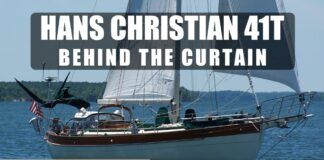
Hans Christian 41T – Boat Review

Seven dead after superyacht sinks off Sicily. Was the crew at...

What’s the Best Sailboats for Beginners?

Why Does A Sailboat Keel Fall Off?
Latest sailboat review.
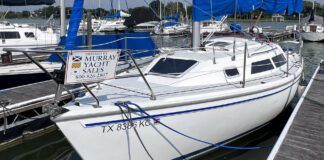
- Privacy Policy
- Do Not Sell My Personal Information
- Online Account Activation
- Privacy Manager

Category A “Ocean” Certification – What Does It Mean?
MJM made it a primary objective that all MJMs would be certified at the highest level of safety possible… which meant those models under 40 feet are ISO CE Certified Category B Offshore, while the 40z and 50z are Certified ISO CE Certified Category A Ocean. There are no other boats of their type, of any size, achieving this high level of offshore safety. In fact, in the worldwide database of the International Marine Certification Institute (IMCI), we have only identified two other models under 40-feet with this certification, both being heavy displacement trawlers. The former achieves this with a low vertical center of gravity and the latter with massive tonnage. What does ISO Certification mean and how should it affect one’s peace of mind on the water? Let’s take a look at the subject.
When the European Union started in 1998, a Recreational Craft Directive was developed to set design/building standards for recreational boats up to 24 meters (79 feet). New and used boats sold in Europe, including boats built in the U.S. or anywhere else being exported to Europe, had to be certified as complying with one of four design categories for seaworthiness. These categories are based on factors such as the wave height and wind speed a given design is capable of handling, plus hull scantlings/strength and stability.
In essence, the further offshore a vessel is expected to venture, the greater the requirements for the vessel’s construction strength, stability, reserve buoyancy, resistance to flooding, deck drainage, crew safety, and other seaworthiness criteria have to be. Let’s take a look at the four categories.

Category A — Ocean – This is the category with the toughest standards and covers vessels 40’ and over designed to be self-sufficient for extended voyages. It is defined as the “category of boats considered suitable for seas of up to 23 feet (7 meters) significant wave height and winds of Beaufort Force 9 (41-47 knots) or less, but excluding abnormal conditions such as hurricanes.”
Category B — Offshore – These boats are designed to go offshore with the ability to handle winds up to gale force 8 of 40 knots, and seas up to 13 feet (3.96 meters).
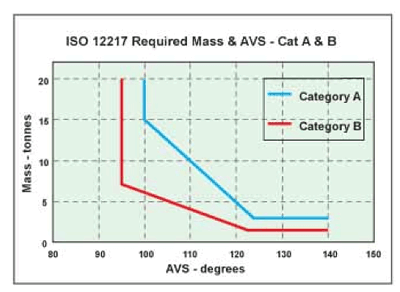
The difference between Category A & B is shown in the above graphic, where Mass is tons and AVS is the Angle of Vanishing Stability when the boat goes upside down. Category A boats need to be to the right of and above the blue line and a Category B boats to the right and above the red line.
Category C — Inshore – These boats may venture away from the protected harbors, but within striking distance of home… operating in coastal waters or large bays and lakes with winds up to 27 knots with and significant seas 8 feet (2.44 meters) high.
Category D — Inland or sheltered coastal waters – These are your typical day boats, operating in protected harbors, small lakes and rivers with winds to Force 4 (up to 16 knots) and significant wave heights to 4 feet (1.22 meters).
Now This Is Important
While a builder may claim that a boat is designed to a certain standard, it doesn’t necessarily mean that it ends up being built to it, unless inspected and certified by an IMCI (International Marine Certification Institute) surveyor, AND the builder can show you this plaque affixed to a bulkhead.
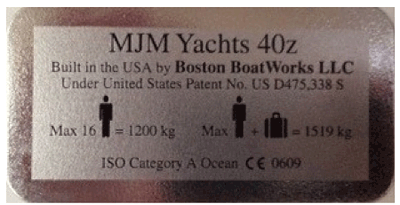
Because the number of people in the boat can reduce stability, the plaque shows the max number of people for Category A conditions, which on the 40z is 16. That’s not a USCG limit for liability purposes at all times. That’s just for Category A conditions.
Good story here. When Bob Johnstone was told that the 50z could carry only 2 more people under Category A than the 40z (18 versus 16), he was concerned about losing a 50z sale to a 40z owner who was moving up, because he wanted to be able to take 20 or so friends on the ICW to eat at Coconuts Restaurant near Bahia Mar… and might be concerned about the liability. “No worries,” said the IMCI surveyor, “We can provide the 50z with a ‘B’ rating as well as an ‘A’ rating, showing he can carry 30 people…and if he’s just going down the ICW or close to shore, you can post a ‘C’ rating, too, showing a capacity for 50 people.” Bob thought was going a bit too far and was happy to settle with the following plaque for the 50z.
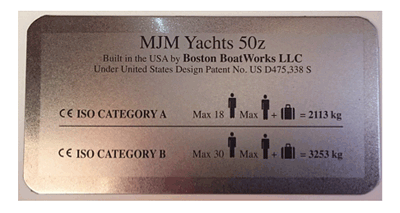
Impact on Design and Manufacturing?
MJM Yachts is dedicated to producing the safest, strongest and most durable yachts possible. For this reason, while those under 40 feet can only be rated “B,” each of our powerboats is designed and built to exceed small craft structural requirements for ISO Category A Ocean. ISO requirements for strength are based on a design’s top speed and the expected impact to be absorbed by hull bottom and sides, as well as decks, bulkheads, structural grid, and any part of the vessel’s structure. The laminate schedule and materials are then specified to meet such stringent requirements.
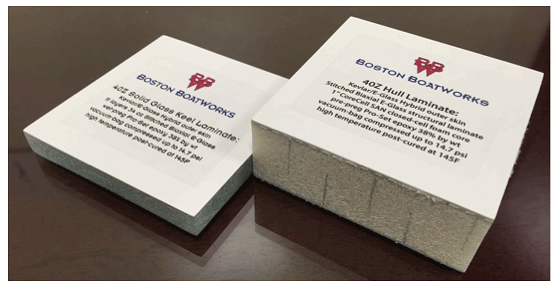
ISO standards for polyester or vinylester resin and the 50:50 glass-to-resin ratio are lower than those achieved on MJMs, built by Boston Boatworks. An MJM is built using a wet prepreg epoxy, Kevlar, Eglass and Corecell with a glass-to-resin ratio of 62:38. Epoxy is significantly more expensive, but 25% stronger, unlikely to crack with use, and is water-resistant… which is why epoxy is used to coat the bottom of boats suffering from osmotic blistering. The MJM is built right from the start!

That’s Not All…
ISO CE certification also takes into account engine emissions. In a world where greenhouse emissions are taking their toll on our environment, this is an important point. Meeting strict ISO CE emissions standards is comparable to meeting similar U.S. CARB requirements.
Additionally, sound levels will come into play. Boats are limited to 75 decibels for a single engine and 78 decibels for twin, triple or quad installations from a distance of 25 meters.
Highest Standards for MJM Yachts
MJM meets and exceeds all applicable standards, because ISO CE standards are more stringent than those of the United States Coast Guard (USCG), American Boat and Yacht Council (ABYC), or National Marine Manufacturers Association (NMMA) which mirror ABYC.

Boats sold in the U.S. do not have to be ISO CE certified… which costs upwards of $20,000 per model. USCG regulations require safety items such as PFDs and flares, carrying capacity for boats under 26 feet (7.93 meters), and level flotation if swamped for boats 20 feet (6.1 meters) and under. ABYC has distributed American versions of ISO CE Standards and Recommendations…but, they are strictly voluntary. Most critically, there are no ABYC design categories to differentiate between boats of different capabilities suitable to differing sea and wind conditions.
NMMA certification in the U.S. requires only about 70% of the ABYC recommended standards. While most U.S. builders follow the ABYC standards, and indeed many exceed those required by the NMMA, they are not mandatory as is the case in Europe with ISO CE mark standards and don’t involve the cost and post-build survey inspection of ISO.
The MJM Category A Ocean certification ensures MJM owners are boating on a stronger, more stable yacht, designed and built to exceed the highest standards in the world. It means having the peace of mind that comes with knowing that should you find yourself in weather and sea conditions outside your prior boating experience, you will be in one of the safest powerboats in the world. At sea, that comfort is the most important form of comfort a yacht can have.
MJM Yachts – The Luxury of Effortless Driving
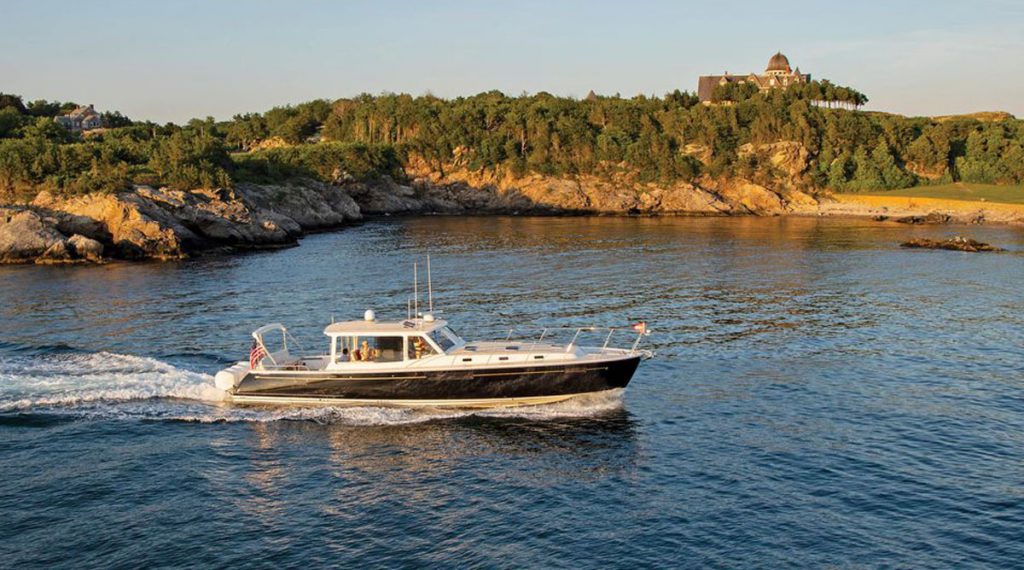
© 2024 mjm yachts, all rights reserved.
- First Name *
- Last Name *
- Models * I'm Interested in* 3z 35z 43z 43zi 53z 53zi
- Home Port *
- Boat Model & Year Built
- Phone This field is for validation purposes and should be left unchanged.
Pamlico Yachtworks Department: Accounting Position: CFO
Pamlico Yachtworks seeks CFO well-versed in all aspects of financial management ranging from simple accounting to broad investment and banking operations.
Key attributes for candidates:
- High-plant-touch orientation
- High technical financial, accounting and tax expertise, along with
- Exceptional “affability/teaming” attributes, in
- Complex, mid-tier manufacturing environments
Employee Duties & Responsibilities
- monthly/periodic financial reports and analyses.
- projections and budgets
- reconciliation with requisite supporting information for accurate presentation of the financial reports.
- Oversees the accounting function (accounting, accounts payable and payroll) and billing and collections functions of the organization.
- forecasting cash flows and operating results
- presenting financial and other information to the leadership team and the Board of Directors.
Requirements and skills
- Proven experience as CFO, finance officer or relevant role
- In depth knowledge of corporate financial law and risk management practices
- Excellent knowledge of data analysis and forecasting methods
- Proficient in the use of MS Office, MS Excel, QuickBooks, ERP and financial management software
- CPA is a strong advantage
- BSc/BA in Accounting, Finance or relevant field; MSc/MBA is a plus
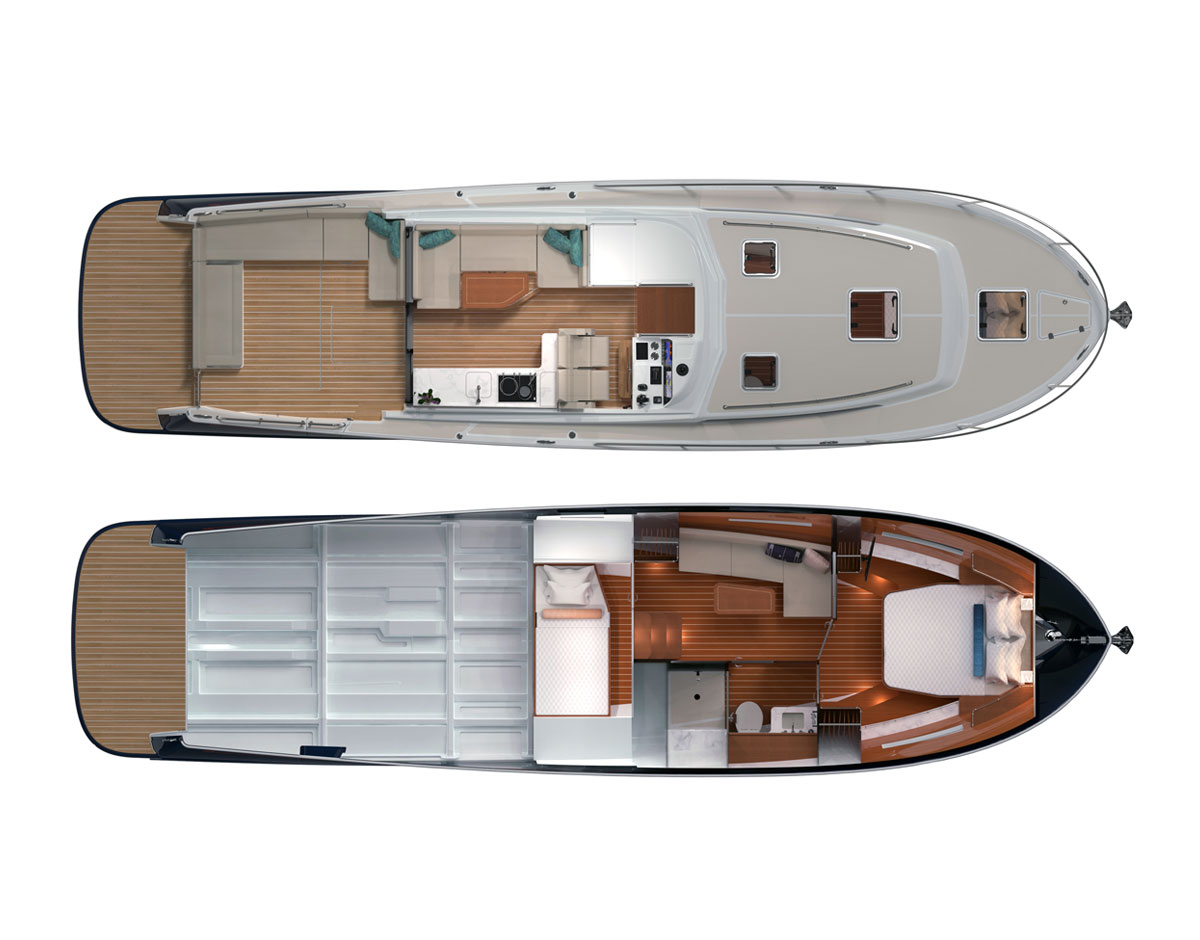
Stay in the know. Get the latest information on MJM Yachts including new models, events, & more.
By submitting this form, you are consenting to receive marketing emails from: MJM Yachts. You can revoke your consent to receive emails at any time by using the unsubscribe link, found at the bottom of every email.
A Zurn Design

The global authority in superyachting
- NEWSLETTERS
- Yachts Home
- The Superyacht Directory
- Yacht Reports
- Brokerage News
- The largest yachts in the world
- The Register
- Yacht Advice
- Yacht Design
- 12m to 24m yachts
- Monaco Yacht Show
- Builder Directory
- Designer Directory
- Interior Design Directory
- Naval Architect Directory
- Yachts for sale home
- Motor yachts
- Sailing yachts
- Explorer yachts
- Classic yachts
- Sale Broker Directory
- Charter Home
- Yachts for Charter
- Charter Destinations
- Charter Broker Directory
- Destinations Home
- Mediterranean
- South Pacific
- Rest of the World
- Boat Life Home
- Owners' Experiences
- Conservation and Philanthropy
- Interiors Suppliers
- Owners' Club
- Captains' Club
- BOAT Showcase
- Boat Presents
- Events Home
- World Superyacht Awards
- Superyacht Design Festival
- Design and Innovation Awards
- Young Designer of the Year Award
- Artistry and Craft Awards
- Explorer Yachts Summit
- Ocean Talks
- The Ocean Awards
- BOAT Connect
- Between the bays
- Golf Invitational
- BOATPro Home
- Superyacht Insight
- Global Order Book
- Premium Content
- Product Features
- Testimonials
- Pricing Plan
- Tenders & Equipment
Yacht classification definitions
The merchant shipping sector is ruled by safety regulations developed since the beginning of the 20th century, and is familiar with international conventions such as SOLAS, MARPOL and Load Lines. But the application of common safety requirements to pleasure vessels is something relatively new – a continuous work in progress – and is very much dependant on the service and the flag of the yacht.
Defining the problems
Definitions do not help. How often have we read of large yachts, superyachts, megayachts, gigayachts or other bombastic adjectives? How many times have we mentioned MCA, RINA, and Lloyd’s, without having a clear idea of who’s doing what?
A good starting point for understanding the subject is to clarify the main definitions and the roles of the main players:
Large yacht
A large yacht is a pleasure vessel with a load line length equal to or over 24m. Almost all the flag administrations have adopted safety codes dedicated to large yachts and this is, therefore, the only definition having a universal meaning in the international regulatory framework of yachts.
Commercial yacht
A motor or sailing vessel in commercial use (i.e. charter) for sport and pleasure, carrying no cargo and not more than 12 passengers.
Private yacht
A pleasure vessel solely used for the recreational and leisure purpose of its owner and his guests.
Flag administration
The government of the state whose flag the yacht is entitled to fly . This administration sets the safety regulations, manning requirements and fiscal aspects relevant to the yacht registration.
Different flag administrations can inspect the safety aspects of yachts with their own inspectors (see MCA for example) or delegate this activity partially or totally to other recognised bodies such as the classification societies.
The main flag authorities in the yachting industry are: The UK-MCA, Cayman Islands, Isle of Man, Malta, the Marshall Islands, Italy and Luxembourg.
Classification societies
Organisations that establish and apply technical standards in relation to the design, construction and survey of ships.
Classification rules are developed to assess the structural strength and integrity of the essential parts of the hull, the reliability and function of the propulsion, steering systems, power generation and all the other features installed on board which contribute to guarantee the main essential services.
In addition to this ‘third party check’ function, class societies carry out statutory duties on behalf of the major flag administrations in accordance with specific delegation agreements signed with each government.
The main class societies involved in yachting are: American Bureau of Shipping, Bureau Veritas, Det Norske Veritas, Germanischer Lloyd, Lloyd’s Register, and RINA.
Large yachts: Applicable rules and certificates
Private yachts
The mandatory requirements for these boats are very light. For the majority of flag states, a registration survey and a tonnage measurement, carried out by an authorised surveyor, are sufficient.
The only mandatory international conventions are those relevant to the marine environment: MARPOL and the Anti-Fouling System Convention.
The International Convention for the Prevention of Pollution from Ships (MARPOL) is intended to eliminate the intentional pollution and to minimise the accidental pollution of the marine environment caused by harmful substances.
The Anti-Fouling System Convention’s purpose is to eliminate the presence of harmful substances for the marine environment contained in anti-fouling paints applied to ships.
Classification
While classification is not mandatory, building and maintaining a private yacht in class is the only evidence that the boat has been designed, constructed and operated in compliance with appropriate technical standards. It is therefore highly desirable, especially in relation to insurance and re-sale purposes.
Commercial yachts
All flag administrations require commercial yachts to be certified in accordance with a specific large yacht safety code.
The most popular of these safety codes, and the first that was developed, is the MCA Large Commercial Yacht Code (LY2) published in 2004. It replaced the Code of Practice for the Safety of Large Commercial Sailing and Motor Vessels (LY1) published in 1997.
LY2 is applied by the Red Ensign Group Flags (UK, Cayman Islands, Isle of Man, Bermuda, Gibraltar, British Virgin Islands, etc.) and is recognised as a reference standard for all the yachting industry.
Other flags have developed similar codes. Luxembourg, Italy, Marshall Islands, Malta, Belize and The Netherlands are some examples.
While introducing a stricter set of rules and regulations compared to private yachts, commercial registration offers yacht owners the possibility of making a profit from the chartering activity of their boats, and allows them to take advantage of all the other benefits of a commercial operation (in particular VAT exemption on the purchase, sale, bunkering, provisions, dry-docking, and others).
Mandatory certificates
The number and type of the mandatory certificates depends on the size of the vessel; the following is an indicative list:
- International Tonnage Certificate : A measurement of the internal volumes of the yacht expressed in gross tons (GT). This measurement should not be confused with displacement tonnage, which quantifies the weight of a vessel.
- Large Yacht Code Certificate : Covers life-saving appliances, fire protection and means of escape, navigational and signalling equipment, intact and damaged stability, manning and crew accommodation.
- Class Certificate : This mainly deals with the yacht’s hull, machinery, electrical equipment and outfitting.
- International Load Line Certificate : This certifies the weather-tightness of the yacht.
- Safety Radio Certificate : This is applicable if gross tonnage exceeds 300GT This concerns the radio communication and distress installations.
- MARPOL Annex I Certificate : This is applicable if gross tonnage exceeds 400GT This deals with the disposal of oil and bilge water from machinery spaces.
- MARPOL Annex IV Certificate : This is applicable if gross tonnage exceeds 400 or the yacht is certified to carry over 15 persons. This deals with the disposal of sewage from ships.
- MARPOL Annex V : This is applicable to all ships. It covers the disposal of rubbish.
- MARPOL Annex VI : This is applicable if gross tonnage exceeds 400GT as well as to all main and auxiliary engines with a power exceeding 130kW. It concerns the emissions from main and auxiliary engines (NOx and SOx).
- Safety Construction and Safety Equipment : These are additional prescriptions on machinery, electrical parts, life-saving and navigational equipment for yachts with a gross tonnage above 500GT.
- International Safety Management Certificate : This is only applicable to yachts having a gross tonnage greater than 500GT. A certified management company is requested to carry out this service, preparing operational manuals, procedures for drills, and taking care of the maintenance of the yacht and its installations.
- International Ship and Port Security Certificate : This is only applicable to yachts having a gross tonnage greater than 500GT and deals with the anti-piracy certification. A certified management company is requested to provide the ashore assistance and establish on-board procedures and operational manuals.
The GT Factor
The gross tonnage value (GT) is a key issue, not only as a reference for the registration fees applied by the different flag administrations, but also because it determines whether an international convention, rather than a particular safety standard, applies to a yacht.
The table below summarises how the conventions and relevant certificates come into force depending on the gross tonnage of the yacht. In particular, the following values may have a critical impact:
300GT: In many codes, when you reach this value the yacht must be certified in unrestricted service (stricter requirements regarding stability, load line and life-saving appliances).
400GT: This is the threshold for almost all the environmental conventions such as MARPOL and Anti-fouling System.
500GT: This is the threshold for the application of the SOLAS Convention, meaning stricter requirements on machinery, safety systems, materials of construction, fire protection, life-saving appliances and navigational equipment. Furthermore an external certified management company is requested for the ISM and ISPS certifications.
The tonnage issue could also arise on existing yachts when undertaking major refits or modifications, in that any change to the internal volumes of the boat – such as adding enclosed deckhouses or superstructures, or modifying the hull transom or bow – will modify the tonnage value with the risk of subjecting the yacht to stricter mandatory rules.
UPDATE: Since this article was originally published, LY2 has been superseded by Large Commercial Yacht Code Revision 3 (LY3) .
Sign up to BOAT Briefing email
Latest news, brokerage headlines and yacht exclusives, every weekday
By signing up for BOAT newsletters, you agree to our Terms of Use and our Privacy Policy .
More stories
Most popular, from our partners, sponsored listings.
- Seller Market Analysis
- Trade Your Yacht
- Sold Yachts
- We Buy Boats
- Exclusive Listings
- Yachts for Sale
- New Yacht Builds
- Nautor Swan Yachts
- Sichterman Yachts
- Luxury Yacht Charters
- Search Charter Yachts
- Charter Management
- Luxury Events
- Team Members
- Boat Show Events
- North Report Magazine
- Testimonials
- +1.954.900.9988
Blog | Owner’s Guide to Yacht Classification
Yacht classification is a system used to categorize yachts based on various factors such as size, construction, and intended use. The specific classification categories and requirements can vary between different yacht classification societies, but some common classifications include:
- Pleasure Yacht: A yacht intended for leisure use, typically not engaged in commerce.
- Charter Yacht: A yacht that is available for hire for pleasure use, also known as commercial yacht.
- Large Yacht: A yacht that exceeds a certain size or gross tonnage.
- Small Commercial Yacht: A yacht that is used for commercial purposes but does not exceed a certain size or gross tonnage.
- Passenger Yacht: A yacht that is used to carry passengers for hire.
- Workboat: A yacht or vessel intended for work-related use, such as a survey vessel, cable layer, or other specialty use.
- Ocean Going: Yachts that are able to make ocean passages and are built and equipped to meet the requirement of such voyages
- Coastal: Yachts that are intended to operate in coastal and sheltered waters and meeting less stringent requirement than ocean going yachts.
The main differences between yacht classification societies are their specific rules, regulations, and requirements for yacht classification. While many societies have similar overall goals of ensuring that yachts meet certain standards of design, construction, and maintenance, they may have slightly different interpretations of these standards and how they should be applied.
Some societies may have stricter or more detailed rules and regulations than others. For example, one society may have more stringent requirements for fire protection, while another society may place more emphasis on stability calculations.
Another difference is the type of yachts they cover and the services they offer. Some societies focus primarily on pleasure yachts, while others also cover commercial yachts and workboats. Societies may also offer different levels of classification, such as “unrestricted” or “restricted” class, and this might vary depending on the intended use of the yacht.
Lastly, some societies have a more global presence than others, or have more experience or expertise in certain types of yachts or regions. This can be important for yacht owners who plan to take their vessel to different parts of the world and may need to comply with different regulations in different countries.
In short, yacht classification societies are similar in their overall goals, but they can have different rules, regulations, and requirements for yacht classification, different services and different areas of focus. Yacht owners should research and compare different societies to determine which one is the best fit for their specific needs and intended use of the yacht.
There are several yacht classification societies that provide certification and inspection services for yachts and other small vessels. Some of the most well-known include:
- American Bureau of Shipping (ABS)
- Bureau Veritas (BV)
- Germanischer Lloyd (GL)
- Lloyd’s Register (LR)
- RINA (Registro Italiano Navale)
- Det Norske Veritas (DNV) now known as DNV GL
These organizations are responsible for ensuring that yachts and other vessels meet certain standards of design, construction, and maintenance, and they issue certificates of compliance to vessels that meet these standards. They also conduct periodic inspections to ensure that vessels continue to meet these standards over time. Some of them also provide additional services such as collision avoidance, navigation and stability calculations and other specialized services.
Recent Stories
Swan arrow: nautor swan’s power yacht division latest masterpiece set to debut at cannes yachting festival, why now is the perfect time to book your yacht charter for the holidays.

Talk to us Contact Our Team
I understand that by signing up I agree with 26 North’s Privacy Policy .
Welcome aboard!
We have added you to the newsletter.
We have received your information and an agent will get back to you ASAP
Sign up for Yoga On the Docks Tuesdays at 8 AM
We have received your registration. See you on the docks!

- Marine Engineering
- Yacht Services
- Yacht Surveys
- Yacht Electrician
- Megger Testing
- Marina Electrical Services
- Industrial Electrical
- Commercial Electrical
- Residential Building Electrical
- LED Lighting
- Industrial Lighting
- Electric Vehicle Charging Stations
- Sales & Parts
- Service Request
- Sales Request

- Privacy Policy
- Terms & Conditions
- RH Marine Group
Understanding Yacht Classifications – Definitions, Explanations, and Regulations
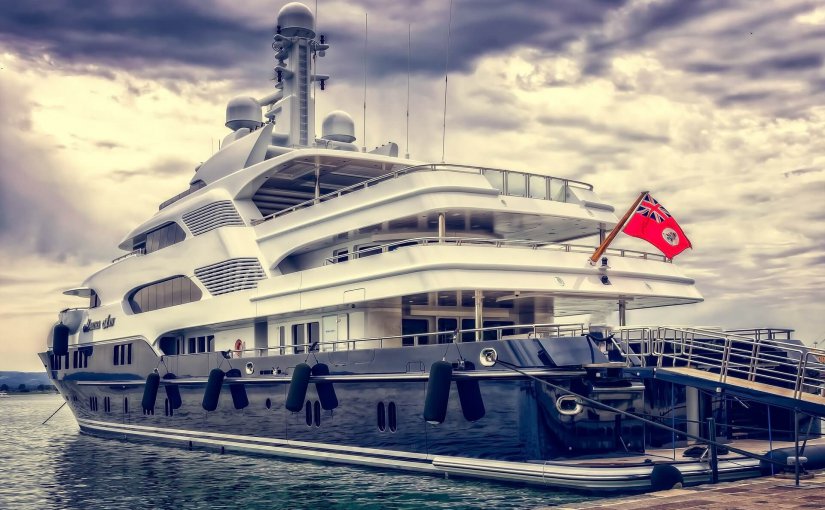
Yacht classifications, also known as classification societies or class societies , are an important part of maritime safety. These classifications dictate the design, construction and ongoing maintenance of large commercial vessels and yachts.
The classifications provide highly detailed and technical standards that cover the yacht’s hull, its engines, and key safety systems. The application of common safety requirements to personal vessels like yachts is something relatively new, so the procedures are constantly evolving. Typically, it is dependant on the service and the flag of the yacht.
Standard Yacht Types
Before discussing the different types of yacht classifications, it’s important to understand the different yacht types. Yachts are typically segmented based on the overall length and how many passengers they can accommodate. The standard yacht classification types are large yachts or luxury sailing yachts, commercial yachts, and private yachts.
Large Yachts
Large yachts, also known as luxury yachts, is the largest classification type for yachts. A large yacht has a load line length equal to or over 24m or about 80 feet. Just about every flag administrations have adopted safety codes for large yachts. Therefore, this is the only yacht definition having a universal meaning in the international regulatory framework of yachts.
Commercial Yachts
Commercial yachts are ones that are used for commercial use, whether it be sport or charter. These ships do not transport or carry any cargo and carry no more than 12 passengers.
All flag states require that commercial yachts are certified in accordance with a specific large yacht safety code. The most widely used safety code is the MCA Large Commercial Yacht Code (LY2) published in 2004.
Private Yachts
Private yachts are typical pleasure vessels used for the recreational and leisure purpose of its owner and his guests. In some cases, they are also known as cruising yachts.
What Is A Classification Society?
Classification societies are organizations that set the rules that govern the construction, maintenance, and operation of yachts and vessels. Currently, there are 13 members of the International Association of Classification Societies . Classification societies were first started when insurance underwriters at Lloyd’s of London set standards for the ships that they would ensure.
As a result, Lloyd’s Register of Shipping (LR) was the original classification society. While many of the 13 members do not classify yachts, they cover everything from container ships to supertankers.
The main class societies involved in yachting are the American Bureau of Shipping, Bureau Veritas, Det Norske Veritas, Germanischer Lloyd, Lloyd’s Register, and RINA.
What Is A Flag State?
A vessel’s flag state is the jurisdiction or nationality under whose laws the vessel is registered or licensed. The flag state has the authority and responsibility to create regulations for vessels registered under its flag. These typically involve those relating to the inspection, certification, and issuance of safety and pollution prevention documents for a vessel.
Different flag administrations may perform inspections on the safety aspects of yachts using their own inspectors or use classification societies or other recognized organizations to perform these inspections.
The main flag authorities in the yachting industry are the UK-MCA, Cayman Islands, Isle of Man, Malta, the Marshall Islands, Italy, and Luxembourg.
What Is The Classification Process
The first step of classification involves the assessment of a yacht’s designs and regular inspections during the construction or conversion of a yacht. Once it is confirmed that all standards have been met, a certificate of classification is issued.
The certificate details the standards met, the intended use for the vessel, and whether the vessel should be used only in sheltered waters. The certificate is evidence that a yacht meets industry standards but isn’t necessarily a guarantee of seaworthiness.
Maintaining classification is achieved through regular surveys. These surveys, also known as ‘special’ surveys, typically take place every five years. These surveys assess things like the thickness of the hull, possible fractures, and other potential damage. They also consider the condition of electrical systems, machinery, and equipment.
Mandatory Classification Certificates
There are a variety of different classification certificates. The number and type of the mandatory certificates for a given ship will depend on its size.
International Tonnage Certificate This expresses the internal volumes of the yacht in gross tons. Unlike displacement tonnage, this does not quantify the weight of a vessel.
Large Yacht Code Certificate This certificate covers navigational and signaling equipment, life-saving appliances, fire protection, means of escape, and manning and crew accommodation.
Class Certificate This mainly deals with the yacht’s hull, machinery, electrical equipment, and outfitting.
International Load Line Certificate This certificate covers the weather-tightness of the yacht.
Safety Radio Certificate This certificate only applies if gross tonnage exceeds 300GT. It covers radio communication and distress installations.
MARPOL Annex I Certificate This certificate only applies if gross tonnage exceeds 400GT and covers the disposal of oil and bilge water.
MARPOL Annex IV Certificate This certificate only applies if gross tonnage exceeds 400GT or the yacht is certified to carry more than 15 people and covers the disposal of sewage from ships.
MARPOL Annex V This certificate covers the disposal of rubbish and applies to all ships.
MARPOL Annex VI This is applicable if gross tonnage exceeds 400GT as well as to all main and auxiliary engines with a power exceeding 130kW. It concerns the emissions from main and auxiliary engines (NOx and SOx).
Safety Construction and Safety Equipment These cover machinery, electrical parts, life-saving and navigational equipment for yachts with a gross tonnage above 500GT.
International Safety Management Certificate This only applies to yachts with a gross tonnage greater than 500GT. A certified management company is requested to carry out this service, preparing operational manuals, procedures for drills, and taking care of the maintenance of the yacht and its installations.
International Ship and Port Security Certificate This only applies to yachts and ships with a gross tonnage greater than 500GT and covers the anti-piracy certification. A certified management company is requested to provide ashore assistance and establish onboard procedures and operational manuals.
Keeping Your Yacht Up To Classification
Tess Electrical has years of experience in maintaining yachts and commercial vessels. We deal with vessels 125’ and above, which have more complex systems dictated by Classification, Flag State and Insurance requirements. Even if vessels are not classed, we can still maintain them to those standards.
Give us a call or send us an email to speak with one of our experienced marine engineers about developing a maintenance strategy for your yacht today.
Recent Posts

We are a Marine Electrical Service Company servicing mostly in the Large Mega Yacht Industry and Marine Land Installations (marinas, resorts, apartments, docks, etc). We have mobile Technicians who cover the tri county area (Broward, Palm Beach and Dade) in their fleet of vehicles.

- Marine Electrical
- Land Division
- ShipServ Ship Supply
Our Services
- Fluorescent To LED Conversion
- All Land Services
- All Marine Services
Sales & Support
- Sales Request Form
Our Location
Tess Electrical LLC
Certified Boats
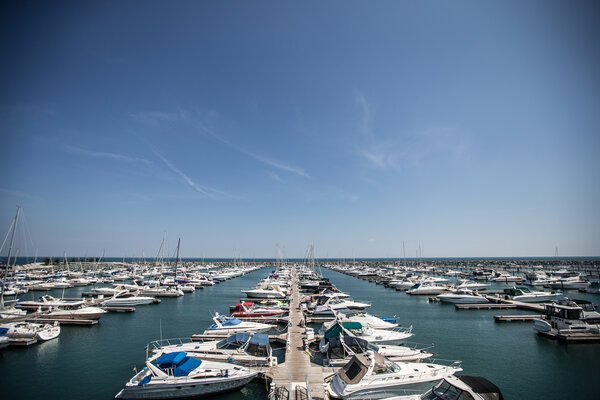
NMMA Certification
Look for this NMMMA Certified logo when purchasing a boat.

NMMA Certification is a program designed to help boat manufacturers comply with industry safety and construction standards and federal regulations. In order to be NMMA Certified, boat manufacturers must certify each boat model they produce. In addition to boat certiification, a dealer can also get a Marine Five Star Certification to ensure that buying and maintaining a boat are pleasant experiences.
View Certified Boat Brands
How to find an NMMA Certified boat or yacht
- Ask your dealer
- Visit NMMA Boat Shows , Most show directories indicate who is NMMA Certified.
- Look for the NMMA Certified logo on the capacity plate of boats up to 26' or on the yacht plate of yachts 26' and larger. Plates are usually located near the helm.
Why Should You Buy a Certified Boat?
What Does NMMA Certification Mean?
All boats sold in the U.S. must meet U.S. Coast Guard minimum regulations. NMMA Certified boats must also meet the more comprehensive standards set by the American Boat & Yacht Council (ABYC), covering more systems and components than USCG regulations.
NMMA Certified boats undergo third-party inspection to ensure all applicable standards are met; the result is a thoroughly inspected, high-quality boat for you and your passengers.
What does Certification cover?
The NMMA Certification program covers over 30 categories of standards, which vary by boat type and may include:
- Fuel systems
- Ventilation
- Passenger and weight capacity (on boats under 26')
- Horsepower Capacity (on boats under 20')
- Flotation (on boats under 20')
- Electrical systems
- Navigation lights
- Warning label placement and guidelines
- Steering systems
How does a boat become Certified?
Manufacturers build a boat to ABYC and USCG standards under the guidance of the company's NMMA-trained Certification specialist.
NMMA inspects the completed boat to make sure it meets the established standards. If any oversights are found, the manufacturer must bring the boat to compliance by completing and documenting the necessary changes.
Boats that successfully pass this inspection process are considered NMMA Certified.
How do I know if a boat is NMMA Certified?
Look for the NMMA Certified logo on the capacity or yacht plate, located near the helm. Ask your dealer.

ABYC Standards

Unlike for cars, there are relatively few federal regulations regarding the construction of boats. There are requirements for fire extinguishers, life jackets, navigation lights and visual distress signals but these have little to do with how a boat is built and more to do with meeting minimal safety requirements. For the most part the government in the U.S. has left it up to private industry to create a body of guidance for building safe recreational boats.

An ABYC Surveyor inspects a motor
Founded in 1954, the American Boat & Yacht Council (ABYC) in a non-profit, member organization that develops voluntary safety standards for the design, construction, maintenance, and repair of recreational boats. ABYC to keep boating safe and enjoyable by making sure that a boat's construction is not at fault if something does not go according to our plan on the water. The standards and technical information reports cover all the major boat systems and the development and annual review of these standards correlates directly to the significant reduction in the number of boating accidents over the past six decades.
In 2003, NMMA and ABYC made an agreement that strengthens each organization’s efforts to encourage broad use of ABYC Standards and the NMMA Boat & Yacht Certification Program. More than 180 boatbuilders now build to the standards and 90% of the boats sold in the U.S. today are certified.
Visit www.abycinc.org to learn more about ABYC Standards.
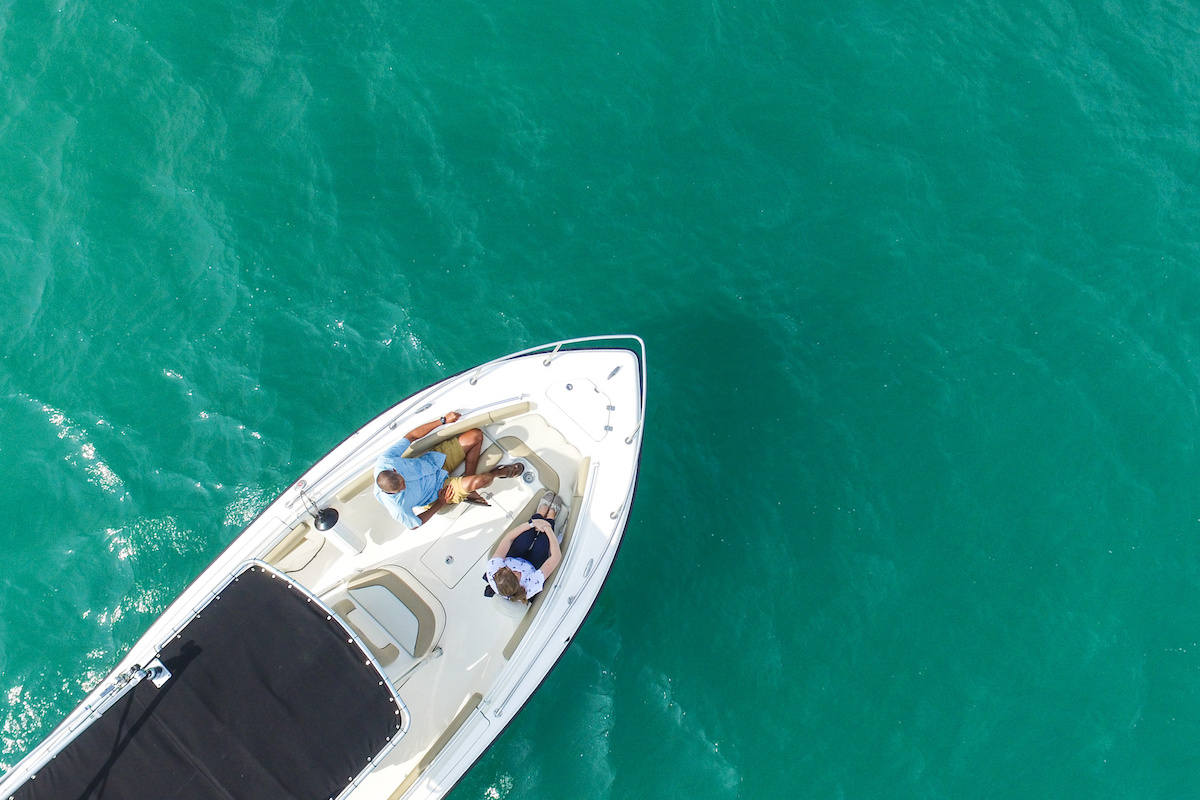
Boat Buyer's Guide
Ready to take the next step towards boat ownership? Explore the Ultimate Boat Buyer's Guide to help you navigate the shopping process.
Join Our Newsletter!
Get community news, buying bargains, and how-to guides at your fingertips.
Cookies on GOV.UK
We use some essential cookies to make this website work.
We’d like to set additional cookies to understand how you use GOV.UK, remember your settings and improve government services.
We also use cookies set by other sites to help us deliver content from their services.
You have accepted additional cookies. You can change your cookie settings at any time.
You have rejected additional cookies. You can change your cookie settings at any time.
Vessel classification and certification
Class and permitted use of passenger ships, cargo ships, tankers, tugs, tenders, fishing boats, yachts, commercial vessels, and the required certificates.
Introduction
All seagoing vessels registered in the UK are assigned to a specific class, which defines their type of permitted use, determines which certification they must hold and specifies the inspection and survey regime required to comply with this certification. These classes are established and assigned by the Recognised Classification Societies, who also approve surveys and inspections.
This guide explains the main classes of UK-registered seagoing vessels, and gives outline details of the statutory certificates they must carry.
Certification requirements for UK vessels
The certificates that you must carry for UK-registered vessels vary according to their type, gross tonnage (gt), type of cargo and whether they are on a domestic or international voyage.
The following is an outline of the main certification requirements:
- passenger ship safety certificate - for all passenger ships
- cargo ship safety radio certificate - for cargo ships, oil tankers, chemical tankers or gas carriers and large commercial yachts over 300gt on international voyages only
- cargo ship safety equipment certificate - for cargo ships, oil tankers, chemical tankers or gas carriers and large commercial yachts over 500gt on international voyages only
- cargo ship safety construction certificate - for cargo ships, oil tankers, chemical tankers or gas carriers and large commercial yachts over 500gt on international voyages only
- cargo ship safety certificate - for cargo ships, oil tankers, chemical tankers or gas carriers and large commercial yachts over 300gt
- load line certificate - for passenger ships in non-UK waters, cargo ships, oil tankers, chemical tankers or gas carriers and large commercial yachts over 24 metres in length (if built on or after 21 July 1968) or of more than 150gt and for passenger ships in UK waters over 80 net tonnes
- oil pollution prevention certificate - for fishing vessels, passenger ships, cargo ships, chemical tankers or gas carriers and large commercial yachts over 400gt and oil tankers over 150gt
- minimum safe manning document certificate - for passenger ships, cargo ships, oil tankers, chemical tankers or gas carriers and large commercial yachts over 500gt
- safety management certificate - for all passenger ships and for cargo ships, oil tankers, chemical tankers or gas carriers and large commercial yachts over 500gt
- ship security certificate - for passenger ships, cargo ships oil tankers, chemical tankers or gas carriers and large commercial yachts on international voyages only
- sewage pollution certificate - for fishing vessels, passenger ships, cargo ships, oil tankers, chemical tankers or gas carriers and large commercial yachts of 400gt or more, or carrying 15 persons or more on international voyages only
- air pollution certificate - for fishing vessels, passenger ships, cargo ships, oil tankers, chemical tankers or gas carriers and large commercial yachts of 400gt or more
- anti-fouling declaration - for fishing vessels under 24 metres in length or of less than 400gt
- anti-fouling certificate - for fishing vessels, passenger ships, cargo ships, oil tankers, chemical tankers or gas carriers and large commercial yachts of 400gt or more
- certificate of fitness (chemical or gas) certificate - for all chemical tankers or gas carriers
- dangerous goods certificate - for passenger ships built after 1 September 1984, and for cargo ships after a certain date of build on international voyages only
- certificate of compliance for a large charter yacht - for all large passenger yachts
- UK fishing vessel certificate - for fishing vessels between 15 and 24 metres in length
- international fishing vessel certificate - for fishing vessels over 24 metres in length
- small commercial vessel certificate - for pilot boats and small commercial vessels under 24 metres in length
- certificate of registry - mandatory for all fishing vessels, optional for pilot boats and small commercial vessels
- international tonnage - for fishing vessels under 24 metres in length
Merchant ships: classification and certification
Merchant ships are classified by the type of cargo that they carry (general cargo, oil, chemicals, gas etc), their gt and the voyages they undertake, which can be:
- inshore, in the sea areas around the UK - for details of these, download Marine Shipping Notice (MSN) 1747 The Merchant Shipping ( Domestic Voyages) Regulations 2000
- short international - when the ship is never more than 200 nautical miles (nm) from a port or place of safety, and on which there is no more than 600nm between the final departure port and the first destination port
- long international - all other voyages between ports in two countries to which the International Convention for the Safety of Life at Sea (SOLAS) applies
The classes of merchant vessels are as follows:
- Class VII - ships (other than those in Classes VII(A), VII(T), XI and XII) engaged on voyages, any of which are long international voyages
- Class VII(A) - ships employed as fish processing or canning factory ships and ships engaged in the carriage of persons employed in the fish processing or canning industries
- Class VII(T) - tankers engaged on voyages, any of which are long international voyages
- Class VIII - ships (other than ships of Classes VIII(T), IX, XI and XII) engaged only on short international voyages
- Class VIII(T) - tankers engaged on voyages, any of which are short international voyages
- Class VIII(A) - ships (other than ships of VIII(A)(T), IX, IX(A), IX(A)(T), XI and XII) engaged only on voyages which are not international voyages - this class includes small commercial vessels
- Class VIII(A)(T) - tankers engaged only on voyages which are not international voyages
- Class IX - tugs and tenders which go to sea but not on long international voyages
Certification for merchant ships
The certificates that merchant ships must carry vary according to class, type of cargo and size. The following is an outline of the main certification requirements for UK ships:
- cargo ship safety radio certificate - for cargo ships, oil tankers and chemical tankers or gas carriers over 300gt on international voyages only
- cargo ship safety equipment certificate - for cargo ships, oil tankers and chemical tankers or gas carriers over 500gt on international voyages only
- cargo ship safety construction certificate - for cargo ships, oil tankers and chemical tankers or gas carriers over 500gt on international voyages only
- cargo ship safety certificate - for cargo ships, oil tankers and chemical tankers or gas carriers over 300gt
- load line certificate - for cargo ships, oil tankers and chemical tankers or gas carriers over 24 metres in length (if built on or after 21 July 1968) or of more than 150gt
- oil pollution prevention certificate - for cargo ships and chemical tankers or gas carriers over 400gt and oil tankers over 150gt
- minimum safe manning document certificate - for cargo ships, oil tankers and chemical tankers or gas carriers over 500gt
- safety management certificate - for all passenger ships, and for cargo ships, oil tankers, chemical tankers or gas carriers and large commercial yachts over 500gt
- ship security certificate - for cargo ships, oil tankers and chemical tankers or gas carriers on international voyages only
- sewage pollution certificate - for cargo ships, oil tankers and chemical tankers or gas carriers of 400gt or more, or carrying 15 persons or more, on international voyages only
- air pollution certificate - for cargo ships, oil tankers and chemical tankers or gas carriers of 400gt or more
- anti -fouling certificate - for cargo ships, oil tankers and chemical tankers or gas carriers of 400gt or more
- dangerous goods certificate - for cargo ships after a certain date of build, on international voyages only
For information about requirements for the certification, see the guidance to legislation
Passenger ships: classification and certification
Passenger-carrying ships are classified primarily on whether they operate inshore or on short or long international voyages.
The classes of passenger ships are as follows:
- Class I - ships engaged on voyages any of which are long international voyages.
- Class II - ships engaged only on voyages any of which are short international voyages.
- Class II(A) - ships engaged on voyages of any kind other than international voyages, which are not ships of Classes III to VI(A).
- Class III - ships engaged only on voyages in the course of which they are at no time more than 70 miles by sea from their point of departure and not more than 18 miles from the coast of the UK and which are at sea only in favourable weather and during restricted periods.
- Class VI - ships engaged only on voyages with not more than 250 passengers on board. In favourable weather and during restricted periods, in the course of which the ships are at no time more than 15 miles from their point of departure, nor more than 3 miles from land.
- Class VI (A) - ships carrying not more than 50 passengers for a distance of not more than 6 miles. Voyages to or from isolated communities on the islands or coast of the UK and which do not proceed for a distance of more than 3 miles from land - this is subject to any conditions which the Secretary of State may impose.
Additional classifications for inshore ships are:
- Class A - passenger ships engaged on domestic voyages other than voyages covered by Classes B, C and D
- Class B - a passenger ship engaged on domestic voyages in the course of which it is at no time more than 20 miles from the line of the coast
- Class C - a passenger ship engaged on domestic voyages in sea areas where the probability of exceeding 2.5 metres significant wave height is less than 10% over a one-year period for all-year round operation; or operating over a specific restricted period (eg summer) in the course of which it is at no time more than 15 miles from a place of refuge, nor more than 5 miles from the line of the coast
- Class D - a passenger ship engaged on domestic voyages in sea areas where the probability of exceeding 1.5 metres significant wave height is less than 10% over a one-year period for all-year round operation; or operating over a specific restricted period (eg summer) in the course of which it is at no time more than 15 miles from a place of refuge, nor more than 5 miles from the line of the coast
Certification for passenger ships
The certificates that passenger ships must carry vary according to their gt. The following is an outline of the main certification requirements for UK ships:
- passenger ship safety certificate
- load line certificate required for passenger ships either operating in UK waters and of more than 80 gross tonnes (gt) or operating in non-UK waters and of 24 metres length (if keel was laid on or after 21 July 1968) or of more than 150gt
- oil pollution prevention certificate - ships of 400gt or more
- minimum safe manning document - ships of 500gt or more
- safety management certificate
- ship security certificate - ships on international voyages
- sewage pollution certificate - ships of 400gt or more, or carrying 15 persons and on international voyages
- air pollution certificate - ships of 400gt or more - application to ships other than on international voyages not yet confirmed
- anti-fouling certificate - ships of 400gt or more
- dangerous goods certificate - ships built after 1 September 1984 on international voyages only
Small commercial vessels and pilot boats certification
The operation of small commercial vessels in the UK is covered by the Small Commercial Vessel Codes of Practice. The Codes define small commercial vessels as those of less than 24 metres load line length (or under 150 tonnes if built before 21 July 1968) which are engaged at sea and are not pleasure vessels..
These vessels are classed as Class VIII (A).
The Codes regulations and classifications apply to UK registered vessels and all other vessels which are registered or owned in another country but operate from a UK port while in UK waters.
Pleasure vessels are not covered by the Codes.
To view the Yellow, Blue, Brown and Red Codes please click here .
Download Marine Guidance Note (MGN) 280 (M) Small Vessels in Commercial Use for Sport or Pleasure, Workboats and Pilot Boats standards from the MCA website (PDF, 921K) .
Certification for small vessels
The specific type of certificate issued depends on operational activities of the vessel - different certificates are issued for vessels used commercially for sport or pleasure, workboats and pilot boats. Commercial vessels that are 24 metres load-line length or over are treated as cargo ships.
Large commercial yachts classification and certification
Large commercial yachts are defined as those vessels which are:
- in commercial use for sport or pleasure
- 24 metres load line length or more or over 150 gross tonnes if built before 21 July 1968
- carry no cargo and no more than 12 passengers
- are in commercial use for sport or pleasure
Certification for large commercial yachts
The certificates that large commercial yachts must carry vary according to their gt. Further information on this can be found in Section 28 of the Large Commercial Yacht Code. You can download MSN 1792 (M) Large Commercial Yacht Code (LY2) .
Fishing vessels: classification and certification
Fishing vessels are classified by length. In general, operation of fishing vessels of less than 24 metres registered length are covered by The Code of Practice for the Safety of Small Fishing Vessels of less than 15m Length Overall and The Code of Safe Working Practice for the Construction and Use of Fishing Vessels of 15m Length Overall to less than 24m Registered Length Fishing Vessels.
Fishing Vessels of 24 metres in length and over are covered The Code of Practice for the Construction and Safe Operation of Fishing Vessels of 24m Registered Length and Over.
Download MSN 1871 (F) The Code of Safe Working Practice for the Construction and Use of Fishing Vessels of 15m Length Overall to less than 24m Registered Length.
Download MSN 1872 (F) The Code of Safe Working Practice for the Construction and Use of Fishing Vessels of 15m Length Overall to less than 24m Registered Length
Download MSN 1873 (F) The Code of Practice for the Construction and Safe Operation of Fishing Vessels of 24m Registered Length and Over
Certification of fishing vessels
Fishing vessels are exempt from some certification requirements, although other specialised certificates must be carried, as follows:
- Small fishing vessel certificate
- UK fishing vessel certificate - for vessels 15-24 metres
- international fishing vessel certificate - for vessels 24 metres or longer
- oil pollution prevention certificate
- air pollution certificate - vessels of 400 gross tonnes (gt) or more
- sewage pollution certificate - vessels of 400gt or more, or carrying 15 persons, and on international voyages
- anti-fouling declaration - vessels of less than 24 metres in length and less than 400gt
- anti-fouling certificate - vessels of 400gt or more
- international tonnage certificate - vessels of 400gt or more
Organisations that can help
As well as guidance on specific types of vessel, more general information on classification, certification and other issues related to the operation of commercial shipping is available from the MCA and the International Maritime Organization (IMO).
Read about the IMO’s work .
Full information on UK regulations and procedures, including details of the certificates that must be carried on UK-registered ships can be found in MCA’s Master’s guide to the UK flag .
Further information
Download the small craft codes from the MCA website
Download MSN 1792 (M) Large Commercial Yacht Code (LY2)
Fishing Vessel (Codes of Practice) Regulations 2017
Organisation information on the MCA website
Agency overview on the IMO website
Download the Master’s guide to the UK flag from the MCA website (PDF, 5.59MB)
Document information
Published: 9 October 2012
Updated: 23 October 2017
From: Maritime and Coastguard Agency
Part of: Ship registration Surveys and inspections
Updates to this page
Links updated
Updated text and links
First published.
Sign up for emails or print this page
Related content, is this page useful.
- Yes this page is useful
- No this page is not useful
Help us improve GOV.UK
Don’t include personal or financial information like your National Insurance number or credit card details.
To help us improve GOV.UK, we’d like to know more about your visit today. Please fill in this survey (opens in a new tab) .
You are using an outdated browser. Please upgrade your browser to improve your experience.
Certification
Nmma certified boats, yachts, boat trailers, and components set the standard for reliability, safety and quality worldwide.
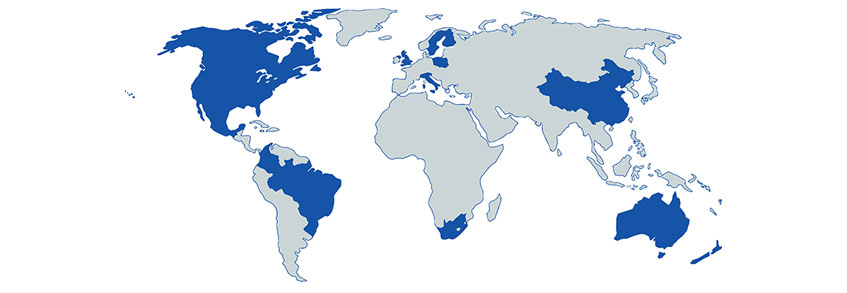
As the leading certification body for the recreational boating industry in the U. S., NMMA Certification impacts the recreational marine industry worldwide, helping to improve boat manufacturing and ensure quality products for consumers throughout the world.
Our global team of inspectors have extensive knowledge of the marine industry, with expertise in manufacturing, operations, engineering, and quality assurance and are well-versed in both domestic and international standards.
NMMA also requires that the following components be NMMA Type Accepted when used on NMMA certified boats and yachts: bilge blowers, bilge pumps, fuel hoses, fuel tanks, horns, navigation lights, steering helms, and steering wheels.
Global Reach:
Boat & Yacht Certification: 13 countries | 189 manufacturers
PWC Certification: 2 countries | 5 manufacturers
Type Accepted Components: 14 countries | 98 manufacturers
ECT Certification Software
To log into the new ECT Certification Software please follow the link at www.ect.nmma.org
*You will need to reset your password by selecting "forgot your password" and follow the instructions which will be emailed to you. If you do not receive the email, please check your spam folder.
Engineering Software Training Tutorials
Boat and Yacht Certification Software Training Tutorial
Trailer Certifiation Software Training Tutorial
Type Accepted Software Training Tutorial
Capacity Tag Order Form Tutorial
Oil Brand Registration/Renewal Tutorial
Oil Formulation Tutorial
NMMA Engineering Standards Department manages NMMA Certification, the premier product certification program for boats, yachts, boat trailers, PWC and marine oils in the United States. It's our mission to help marine manufacturers succeed in providing safer products for the boating industry.
NMMA Boat & Yacht Certification helps manufacturers ensure their boats are built to applicable standards set by the American Boats & Yacht Council (ABYC), and to promote their compliance to the public.

Trailer Certification
NMMA helps boat trailer manufacturers comply with industry standards.

Check out the latest news from NMMA and around the industry.
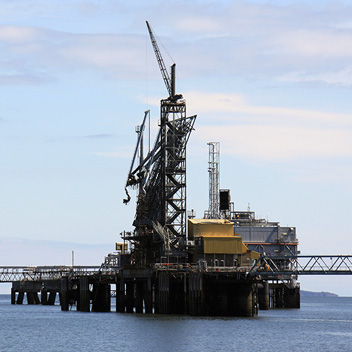
Oil Certification
NMMA has developed a certification program for premium-quality engine lubricants.

- Standards Library
- Standards Development
- Technical Toolkit
- Become a Member
- Member Benefits
- Member Toolkit
- Member Directory
- Online Learning
Certification Program
- Certified Tech Marketing Toolkit
- Curriculum for Educators
- School Accreditation
- Events Calendar
- Rent Our Venue
- Scholarships
- Workforce Development
- Technical Board
- Media Resources
- 01 Online Learning
- 02 Certification Program
- 03 Curriculum for Educators
- 04 School Accreditation
- 05 Certified Tech Marketing Toolkit
ABYC Certification: A Benchmark in Marine Technical Education
When customers search for top-notch marine technicians, ABYC Certification stands out. Our nationally accredited program hones the skills of technicians and enhances safety by developing comprehensive knowledge of ABYC Standards.
ABYC Certification Highlights
- Nationally accredited program
- Certifications in Marine Systems, Marine Electrical, Marine Corrosion, Marine Engines and Fuel Systems, ABYC Standards, and A/C refrigeration.
- Master Technician credential for those with 3+ certifications
Join over 4,500 marine technicians who have stamped their commitment to safety with ABYC’s Certification.
For Businesses: Commit to Excellence
In the marine industry, the strength of your business is often measured by the skills of your technicians. Solidify your position as a trusted leader in boat service and repair.
- Demonstrated Commitment to Industry Standards
- Enhanced Credibility
- Increase Customer Loyalty
For Individuals: Do Your Work to the Standards
Stand Out with ABYC Certification. Deliver peace of mind to every boater by maintaining the highest levels of safety, reliability, and performance on the water
- Continuous Learning
- Gain Industry Credibility
- Boost Your Career
Professional Certifications Include:
Marine standards, marine systems, marine corrosion, marine electrical, marine composites, a/c refrigeration, advanced marine electrical, marine engines and fuel systems, service management, how to become abyc certified.
Classes are taught by industry professionals/ABYC Certified Technicians and held around the world and online. ABYC Certifications are verified by the third party NOCTI Business Solutions, ensuring relevance and value. Exams are all multiple-choice questions measuring your knowledge in different areas. Upon passing, certifications are active for 5 years.
How to Earn a Professional Certification
- Take a Certification course – View calendar
- Self-study and test with a proctor – Learn more here
Recertification
To maintain your ABYC Professional Certification you must take the shorter recertification exam and fulfill a CEU requirement. Recertification is a simple process that re-establishes your educational standing in the industry.
On-site Courses
ABYC Business members can choose to host its own in-person or virtual class. Businesses can host the location and fill the course with their own attendees for a set price to ABYC, which includes the study guides, exams and a dedicated instructor.
Certification Designations
ABYC recognizes that many different types of marine industry professionals desire ABYC professional certifications, however not all of those individuals are physically working on boats. Many are in an advisory or consulting position and have a need for the same type of knowledge, but lack the practical skills that are necessary by service and installation technicians. ABYC has created certification designations to better associate the type of work being done by the individual.
Advisor Certification
Designed for people who work within the marine service sector that desire an ABYC certification but do not physically work on boats performing repairs.
Examples: Marine surveyors, customer service representatives and engineering standards compliance specialists.
- Requirements for initial certification: Passing score on certification exam
- Requirements for re-certification: Passing score on re-certification exam + 10 CEUs
- Certifications are valid for 5 years
Technician Certification
Technician certification is the means by which the ABYC and the general public identify those that are actually certified to perform trouble-shooting, repairs and equipment installations on boats.
Examples: Technicians, installers.
- Requirements for initial certification: Passing score on certification exam + 2 years of work experience.
NOCTI Collaboration: Third-Party Validation
Our collaboration with NOCTI underscores the authenticity and rigor of the ABYC Professional Certification Program. Renowned for its commitment to high-quality assessment and validation services, NOCTI’s third-party validation provides an added layer of credibility to our certifications, emphasizing the program’s alignment with the highest industry benchmarks.
Schedule Your Next Class
Become an ABYC Member
Tap into the essential source of technical information.

IMAGES
VIDEO
COMMENTS
The term "Yacht Certified" refers to a quality control process governed by the NMMA, an organization that ensures that yachts and boats are constructed to industry standards. As many as 90% of boats currently on the water in the U.S. carry an NMMA certification placard. The NMMA certification process serves to remove these headaches by ...
Jul 27, 2009. #3. Re: passenger capacity: Yacht Certified - What does this mean? Boats 20' LOA and longer do not need to have the passenger capacity on the certification plate. There are some overly simplistic formulas for determining passenger capacity [number of people = the vessel length in feet times the vessel width in feet divided by 15 ...
Yacht Certification is provided by the National Marine Manufacturers Association (NMMA) to confirm that a particular boat model has been manufactured to meet all ABYC standards of safety, design, and construction. The manufacturer must undergo an annual inspection to maintain certification. To round out the process, each vessel is tagged with a ...
Yacht certification is a process that evaluates a yacht's safety, performance, and overall quality to ensure it meets necessary requirements for safe operation in various waters. Understanding the details of yacht certification is important for all yacht owners to ensure the safety of their vessel and those on board.
When shopping for a new boat, there's one sticker that matters more than the rest. Here's how a boat earns the "NMMA-Certified" logo, and what it means to you. NMMA inspector Steve Carrier examines the engine air intake of a boat under construction. New boats sport a lot of stickers. some warn about the hazards of carbon monoxide, others remind ...
CE Yacht Compliance Classification
For our purposes, though, the term 'yacht' as used by the National Marine Manufacturing Association (NMMA) refers to boats that are 26 ft. or longer, which gets to the heart of why a pleasure-boat owner might want to know what goes into their yacht certification. How the Yacht-Certified Placard Benefits You "Yacht Certification" is a ...
Demystifying yacht classification A, B, C, D
A classification certificate attests that the yacht complies with the standards developed and published by the issuing society. New construction and refit surveys carried out by a surveyor from the classification society under which the yacht is built are important inspections that take place at intervals throughout the duration of the project ...
Lloyd's Register has a number of standards to which builders can construct a yacht. The higher ratings require a Lloyd's inspector to observe construction of the yacht at various phases to insure that the builder's practices meet the rules. The cost of this inspection is inevitably passed along to his customer.
Let's take a look at the four categories. Computer design rendering of the MJM Yachts 50z. Category A — Ocean - This is the category with the toughest standards and covers vessels 40' and over designed to be self-sufficient for extended voyages. It is defined as the "category of boats considered suitable for seas of up to 23 feet (7 ...
A certified management company is requested to carry out this service, preparing operational manuals, procedures for drills, and taking care of the maintenance of the yacht and its installations. International Ship and Port Security Certificate : This is only applicable to yachts having a gross tonnage greater than 500GT and deals with the anti ...
Yacht classification is a system used to categorize yachts based on various factors such as size, construction, and intended use. The specific classification categories and requirements can vary between different yacht classification societies, but some common classifications include: Pleasure Yacht: A yacht intended for leisure use, typically ...
Even clients experienced with the LY3 standard can be surprised by the intricacies of PYC, particularly when it comes to price. There are several code compliance differences between LY3 (for yachts with a maximum of 12 guests) and PYC (for yachts with 12 to 36 guests), all focused on safety while accommodating additional guests and crew.
What's Included on an NMMA Certification Badge. Although U.S. federal regulations only require a boat's passenger capacities to be displayed on boats less than 20 feet long, the NMMA uses ABYC standards to include all powerboats shorter than 26 feet long (and all pontoons), which constitutes an amazing 95 percent of recreational boats on ...
P-28-20. Capacity Plates. S-7-20. Outboard Engine Weight Table. S-30-22. Safety Signs and Labels. T-05-21. Updated ABYC Standards and New Standards for the 2025 MY program in Bold. National Marine Manufacturers Association (NMMA) Boat and Yacht Certification Program Standards Basis for the current Model Year.
Therefore, this is the only yacht definition having a universal meaning in the international regulatory framework of yachts. Commercial Yachts. ... This certificate only applies if gross tonnage exceeds 400GT or the yacht is certified to carry more than 15 people and covers the disposal of sewage from ships.
In 2003, NMMA and ABYC made an agreement that strengthens each organization's efforts to encourage broad use of ABYC Standards and the NMMA Boat & Yacht Certification Program. More than 180 boatbuilders now build to the standards and 90% of the boats sold in the U.S. today are certified. Visit www.abycinc.org to learn more about ABYC Standards.
Per reading the latest edition regarding boat manufacturer members certification program, by 2007, in Boat & Motor Dealer Nov. 11 2004, this program in my opinion is a great attitude toward further safety requirements.I remember the newspaper article written this year concerning the levels of CO poisoning that have occurred and the amount of deaths boaters have experienced in past years.
Boat & Yacht Certification Program | NMMA
Vessel classification and certification
NMMA Certified Boats, Yachts, Boat Trailers, and Components Set the Standard for Reliability, Safety and Quality Worldwide. As the leading certification body for the recreational boating industry in the U. S., NMMA Certification impacts the recreational marine industry worldwide, helping to improve boat manufacturing and ensure quality products for consumers throughout the world.
Technician certification is the means by which the ABYC and the general public identify those that are actually certified to perform trouble-shooting, repairs and equipment installations on boats. Examples: Technicians, installers. Requirements for initial certification: Passing score on certification exam + 2 years of work experience.